





















































































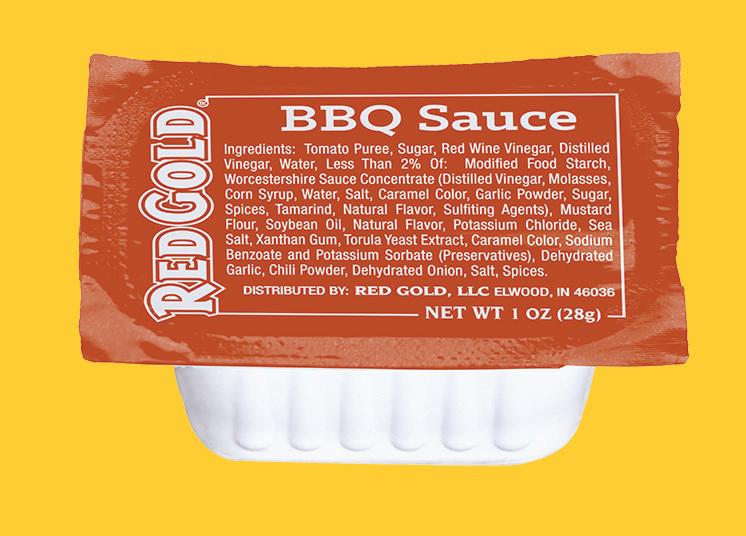

























Red Gold® is here to make your customers’ saucing experience easy and enjoyable with a variety of dunk cup options such as: ketchup, marinara, BBQ, and seafood cocktail sauces. The dunk cups are a convenient way to enjoy on-the-go, delicious sauces with menu items such as fries, burgers, chicken tenders, shrimp, and so much more!

Scan to request a free sample kit!















EDITORIAL
EDITOR EMERITUS
John Lofstock
EDITOR-IN-CHIEF
Erin Del Conte edelconte@wtwhmedia.com
SENIOR EDITOR
Emily Boes eboes@wtwhmedia.com
ASSOCIATE EDITOR
Zhane Isom zisom@wtwhmedia.com
ASSOCIATE EDITOR
Marilyn Odesser-Torpey
ONLINE EDITOR
Kevin McIntyre
CONTRIBUTING EDITORS
Mark Battersby
Anne Baye Ericksen
John Geoghegan
Howard Riell
COLUMNISTS
Mike Maxell
Bruce Reinstein
SALES TEAM
KEY ACCOUNT MANAGER

John Petersen jpetersen@wtwhmedia.com
(216) 346-8790
VICE PRESIDENT, SALES
Tony Bolla tbolla@wtwhmedia.com
(773) 859-1107
REGIONAL SALES MANAGER
Patrick McIntyre pmcintyre@wtwhmedia.com
(216) 372-8112
REGIONAL SALES MANAGER
Simran Toor stoor@wtwhmedia.com
(770) 317-4640
CUSTOMER SERVICE
CUSTOMER SERVICE MANAGER
Stephanie Hulett shulett@wtwhmedia.com
CUSTOMER SERVICE REPRESENTATIVE
Jane Cooper jcooper@wtwhmedia.com
WTWH MEDIA, LLC
LEADERSHIP TEAM
CEO Scott McCafferty smccafferty@wtwhmedia.com
CO/FOUNDER, VP SALES



Mike Emich memich@wtwhmedia.com
EVP Marshall Matheson mmatheson@wtwhmedia.com
CFO Ken Gradman kgradman@wtwhmedia.com
CREATIVE SERVICES
VICE PRESIDENT, CREATIVE DIRECTOR Matthew Claney mclaney@wtwhmedia.com
CREATIVE DIRECTOR Erin Canetta ecanetta@wtwhmedia.com
DIRECTOR, AUDIENCE DEVELOPMENT Bruce Sprague bsprague@wtwhmedia.com
EVENTS
DIRECTOR OF EVENTS
Jen Osborne josborne@wtwhmedia.com
EVENTS MANAGER Brittany Belko bbelko@wtwhmedia.com
EVENTS MARKETING SPECIALIST
Olivia Zemanek ozemanek@wtwhmedia.com
EVENTS COORDINATOR Alexis Ferenczy aferenczy@wtwhmedia.com
VP, ASSOCIATION & COMMUNITY ENGAGEMENT Allison Dean adean@wtwhmedia.com
VIDEO PRODUCTION
VIDEOGRAPHER Garrett McCafferty gmccafferty@wtwhmedia.com
VIDEOGRAPHER Kara Singleton ksingleton@wtwhmedia.com
VIDEOGRAPHER Cole Kistler CKistler@wtwhmedia.com
DIGITAL MARKETING
VICE PRESIDENT, DIGITAL MARKETING Virginia Goulding vgoulding@wtwhmedia.com
DIGITAL MARKETING MANAGER Taylor Meade tmeade@wtwhmedia.com
DIGITAL MARKETING MANAGER


Kayla Polansky kpolansky@wtwhmedia.com
WEBINAR COORDINATOR Halle Kirsh hkirsh@wtwhmedia.com
WEBINAR COORDINATOR Kim Dorsey kdorsey@wtwhmedia.com
DIGITAL DESIGN MANAGER Samantha King sking@wtwhmedia.com
MARKETING GRAPHIC DESIGNER Hannah Bragg hbragg@wtwhmedia.com
WEB DEVELOPMENT

DEVELOPMENT MANAGER Dave Miyares dmiyares@wtwhmedia.com
SENIOR DIGITAL MEDIA MANAGER Pat Curran pcurran@wtwhmedia.com

DIGITAL PRODUCTION MANAGER Reggie Hall rhall@wtwhmedia.com
DIGITAL PRODUCTION SPECIALIST Nicole Lender nlender@wtwhmedia.com
1111 Superior Ave., 26th Floor, Cleveland, OH 44114
Ph: (888) 543-2447
EDITORIAL AND NAG
1420 Queen Anne Road, Suite 4, Teaneck, NJ 07666 Ph: (201) 321-5642
SUBSCRIPTION INQUIRIES
CStore Decisions is a three-time winner of the Neal Award, the American Business Press’ highest recognition of editorial excellence.


EDITORIAL ADVISORY BOARD
Robert Buhler, President and CEO
Open Pantry Food Marts • Pleasant Prairie, Wis.
Lisa Dell’Alba, President and CEO
Square One Markets • Bethlehem, Pa.
Raymond Huff, President
HJB Convenience Corp. • Lakewood, Colo.
Bill Kent, President and CEO
The Kent Cos. Inc. • Midland, Texas
Olivia Beck • Operations
Beck Suppliers Inc. • Fremont, Ohio
Reilly Robinson Musser, VP, Marketing & Merchandising
Robinson Oil Corp. • Santa Clara, Calif.
Bill Weigel, CEO
Weigel’s Inc. • Knoxville, Tenn.
NATIONAL ADVISORY GROUP (NAG) BOARD
Vernon Young (Board Chairman), President and CEO
Young Oil Co. • Piedmont, Ala.
Joy Almekies, Senior Director of Food Services Global Partners • Waltham, Mass.
Mary Banmiller, Director of Retail Operations
Warrenton Oil Inc. • Truesdale, Mo.
Greg Ehrlich, President Beck Suppliers Inc. • Fremont, Ohio
Doug Galli, Real Estate/Government Relations Reid Stores Inc./Crosby’s • Brockport, N.Y.

Derek Gaskins, Senior VP, Merchandising/Procurement Yesway • Des Moines, Iowa
Joe Hamza, Chief Operating Officer Nouria Energy Corp. • Worcester, Mass.
Brent Mouton, President and CEO
Hit-N-Run Food Stores • Lafayette, La.
Robin Hunt, Sales Hunt Brothers Pizza • Nashville, Tenn.
Kyle May, Director External Relations Reynolds Marketing Services Co. • Winston-Salem, N.C.
Tony Woodward, Manager Sr. Account McLane Company Inc. • Temple, Texas
YOUNG EXECUTIVES ORGANIZATION (YEO) BOARD
Kalen Frese (Board Chairman), Director of Merchandising
Warrenton Oil Inc. • Warrenton, Mo.
Jeff Carpenter, Director of Education and Training
2011 - 2020

To enter, change or cancel a subscription, please go to: http://d3data.net/csd/indexnew.htm or email requests to: bsprague@wtwhmedia.com
Copyright 2023, WTWH Media, LLC
CStore Decisions (ISSN 1054-7797) is published monthly by WTWH Media, LLC., 1111 Superior Ave., Suite 2600, Cleveland, OH 44114, for petroleum company and convenience store operators, owners, managers. Qualified U.S. subscribers receive CStore Decisions at no charge. For others, the cost is $80 a year in the U.S. and Possessions, $95 in Canada, and $150 in all other countries. Single copies are available at $9 each in the U.S. and Possessions, $10 each in Canada and $13 in all other countries. Periodicals postage paid at Cleveland, OH, and additional mailing offices. POSTMASTER: Send address changes to CStore Decisions, 1111 Superior Avenue, 26th Floor, Cleveland, OH 44114. GST #R126431964, Canadian
Publication Sales Agreement No: #40026880.
CSTORE DECISIONS does not endorse any products, programs or services of advertisers or editorial contributors. Copyright© 2023 by WTWH Media, LLC. No part of this publication may be reproduced in any form or by any means, electronic or mechanical, or by recording, or by any information storage or retrieval system, without written permission from the publisher. Circulation audited by Business Publications Audit of Circulation, Inc.
Cliff’s Local Market • Marcy, N.Y.
Megan Chmura, Director of Center Store GetGo • Pittsburgh
Ryan Faville, Director of Purchasing
Stewart’s Shops Corp. • Saratoga Springs, N.Y.
Cole Fountain, Director of Merchandise Gate Petroleum Co. • Jacksonville, Fla.
Alex Garoutte, Director of Marketing The Kent Cos. Inc. • Midland, Texas
Daillard Paris, Director of Petroleum Supply and Trading Sheetz Inc. • Altoona, Pa.
















































































Fresh o its 24th acquisition, ARKO Corp., led by CEO Arie Kotler, earmarks over $2 billion for continued mergers and acquisitions (M&A) growth as it integrates recently purchased chains into its portfolio.

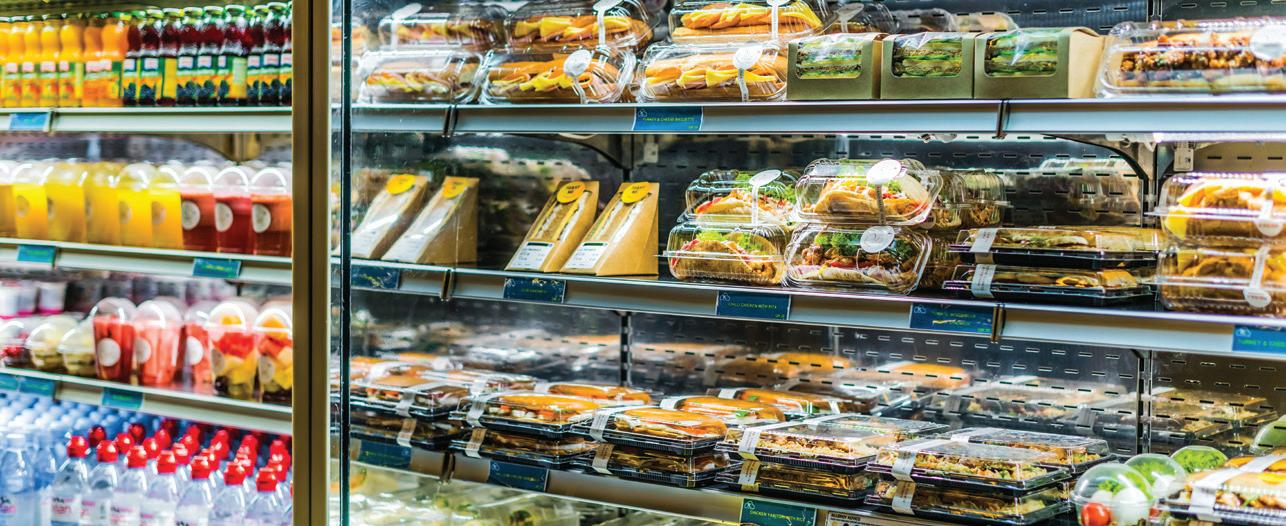


Seeking multi-unit operators and developers to continue IHOP’s growth in travel centers nationwide and offering varied incentives for development.*



• Develop/operate a nationally recognized and trusted brand that will broaden your customer appeal
• 65+ years of giving guests the good comfort food they love and the updated favorites they want to try… at a great value

• A variety of menu options serving all dayparts, giving guests the flexibility of choice
• Updated exterior and interior restaurant design to provide all travelers a comfortable environment at any daypart
• Portable menu items and digital ordering offer a convenient guest experience
Interested in learning more… Contact Us franchising@ihop.com
*Subject to Franchise Agreement and Development Agreement Terms. © 2023 IHOP Franchisor LLC. This is not an offer to sell a franchise. An offer can be made only by means of a Franchise Disclosure Document that has been registered and approved by the appropriate agency in your state, if your state requires such registration, or pursuant to availability and satisfaction of any exemptions from registration. IHOP Franchisor LLC, 10 W. Walnut St., 4th Fl., Pasadena, CA 91103. (866) 995-3463

For any questions about this issue or suggestions for future issues, please contact me at edelconte@wtwhmedia.com.
Today’s c-stores are facing more competition and industry shifts than ever before. Not only are they battling for customer attention against other c-stores, but they’re fending off heightened competition from other channels, including quick-service restaurants (QSRs), grocery stores, drugstores and dollar stores. Delivery apps and e-commerce across industries are also vying for share of customer wallets.
With tobacco regulations on the horizon, fuel efficiency growing and electric vehicle charging expanding, retailers across the industry are taking stock and planning ahead for tomorrow. After all, if there’s one thing this industry does with expert precision, it’s adapt to change and roll with the punches.
I’m reminded of that popular quote (the internet is divided on the author) about how some are lost in the fire and others are built from it. It’s evident that many c-store chains represent the latter. In response to attacks on their business, these c-stores are embracing innovation.
Increasingly, c-stores are adding or upgrading loyalty programs that act as the cornerstones of robust mobile apps and are more personalized to the customer. They’re also doubling down on foodservice as they invest in growing their menus through proprietary offerings. In 30 years, c-store food has gone from the punchline of a joke to high-quality fare that is now competitive with QSRs. Not an easy feat. Would we have reached this milestone if not for the competitive heat?
Alongside an increasing commitment to foodservice, c-stores are giving renewed attention to the dispensed beverage section as customer preferences evolve. As technology continues its rapid rise and stores are now tracking and, more importantly, better integrating and utilizing data, retailers have never had better tools for expertly crafting their planograms.
ARKO Corp., featured in this month’s cover story, is the perfect example of a company not only committed to growth but also focused on evolving its fleet of c-stores to meet the demands of tomorrow.
As it brings recently acquired chains under its umbrella, ARKO is focused on three key pillars: 1.) Focusing on core destination categories, such as candy, packaged beverages, salty snacks, packaged sweet snacks and beer; 2.) Leveraging its fas REWARDS loyalty program; and 3.) Expanding the foodservice and beverage offerings in its stores.
When it comes to the latter, ARKO is growing its proprietary foodservice offerings, including pizza, chicken and prepared sandwiches, roller grill and dispensed beverages, and identifying the price points that resonate with customers across the menu.

A quality loyalty program can especially set a c-store chain apart from the competition.
ARKO relaunched its fas REWARDS program in 2020, and this past March, it upgraded its fas REWARDS app. Its focus on loyalty is paying off. ARKO found its loyalty members took about six times more trips per month than non-loyalty members and spent on average about $60 more per month during Q2 2023.
This month’s Loyalty Program Awards article highlights Gulf Oil and Kum & Go for their recent loyalty program relaunches. Gulf Oil recently relaunched its mobile payments and loyalty program Gulf Pay in March to offer a more sophisticated and personalized loyalty offering.
Des Moines, Iowa-based Kum & Go, which was acquired by FJ Management, parent company of Maverik, at the end of August, revamped its app and loyalty program &Rewards and launched it on Aug. 1. The new app provides flexibility, personalization and a better opportunity for the chain to interact with its customers.
As c-stores look to the future, there’s a lot of uncertainty about just how the landscape will evolve, but savvy retailers, who are letting the competition fuel them, are monitoring trends, testing new innovations, considering how to increase their competitive edge and, most importantly, they’re not afraid of change.










Prasek’s Family Smokehouse, which operates two locations in Sealy, Texas, and El Campo, Texas, isn’t your average convenience store chain.

This smokehouse not only provides traditional cstore products, but it also offers a home-inspired interior, daily lunch specials, a robust bakery offering and a variety of fresh, frozen and smoked meat options.
Like most c-stores, Prasek’s offers convenient fuel pumps, snacks, dispensed beverages and coffee. However, the smokehouse also gives customers the option to shop online and provides other retailers, including 7-Eleven, H-E-B and Road Ranger, with wholesale meat products.
“Even though we fit into the c-store category, we don’t position ourselves as a c-store. We position ourselves as a smokehouse and a stop along the highway where people can come in and dine while offering all the c-store items,” said Duane Korenek,
general operations manager for Prasek’s Family Smokehouse. “We also produce our own smoked meat products and sell them in our retail outlets and across the country as well.”
“We are a destination to truly stop and relax. We want people to come in and feel like they’re at home and feel like family,” added Lannah Stoner, marketing manager for Prasek’s. “We like to say we are a destination for meat lovers, bakery enthusiasts, tourists and locals. Overall, the feel of our stores is what really sets us apart from other c-stores.”
Prasek’s Family Smokehouse started off as a small-town grocery store in Hillje, Texas, owned by Mike and Betty Jo Prasek in 1974. Over the years, the grocery store evolved into the smokehouse it is today, with the first Prasek’s opening in 1981. As the company grew, so did the generations of family members involved in the family business.
Prasek’s Family Smokehouse combines smoked and fresh meat options with traditional c-store fare in a comfortable, welcoming environment.
Zhane Isom • Associate Editor
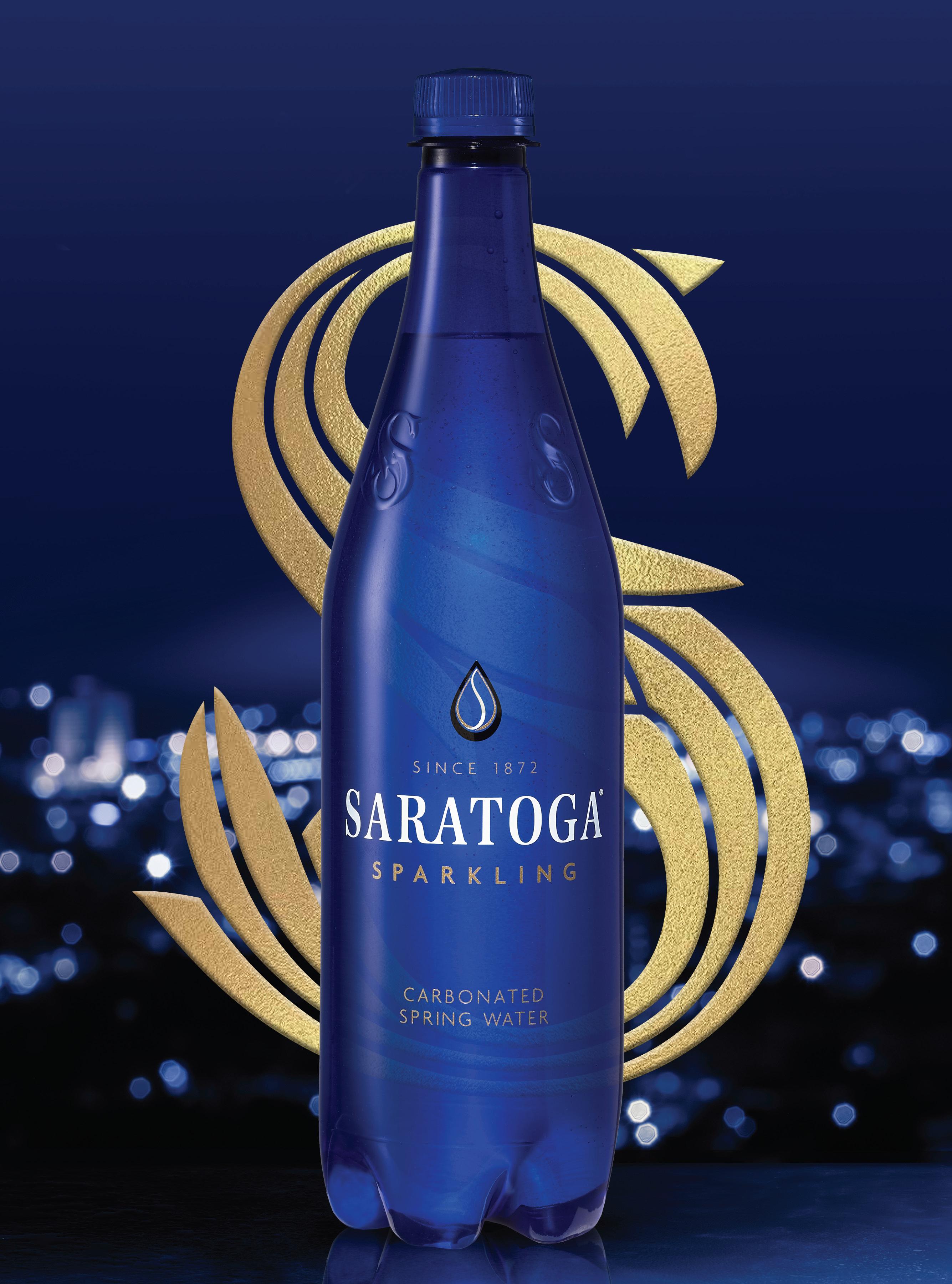
Mike and Betty Jo went on to have three children who currently help run the business. Mike Prasek Jr. is in charge of product management, Michelle Korenek, Stoner’s mother, is in charge of accounting, and Troy Prasek is responsible for general operations.
“Pretty much all of the family members involved in the company joined as kids. However, I have been a part of the company for 30 years,” said Korenek.
Even though Stoner didn’t get involved in the family business until November of 2022, she was always around as a kid given that her grandparents founded the smokehouse and both her parents and in-laws worked there.
“As far as generations go, we are tapping into the third generation of family members working here, which is my sister and I,” Stoner said.
Prasek’s goal is for all its customers to feel like family and be able to relax while visiting the smokehouse. Prasek’s Western home-inspired interior and exterior are what really set it apart from other c-stores and keep customers returning.
“I would describe the outside of our locations to be a dressy Western style, while the interior of the locations is very homey feeling, warm and comfortable, and just a place to stop and relax,” said Korenek. “The interior also has warm tones and color schemes, along with many wood and stone finishes.”
Despite the El Campo and Sealy, Texas, locations offering a comfortable home environment, the two sites provide customers with slightly different features.
“The retail space at our El Campo location is about 19,000 square feet, while our retail space in Sealy is about 42,000 square feet,” said Korenek. “Each location also offers different brands of gas, including Shell and Exxon.”
To make the interior of both locations feel even more like home, both smokehouses offer aspects found in some homes for customers to enjoy and look at while shopping or sitting down to rest.
“Both locations offer fish aquariums, with one being 1,200 gallons and the other being 3,000 gallons, which are pretty big for aquariums,” said Korenek. “The idea behind them is to give our locations the homey feel we pride ourselves on.”
Prasek’s offers its customers a variety of different smoked and fresh meat options to choose from. Whether they are cooked on-site or pre-seasoned for customers to take home and cook, Prasek’s meat offerings are made fresh every day.

“Our fresh meat line is served at our Big H Grill, which comes from our mascot name, where the H stands for Hillje, in reference to where we are stationed. Also, in Big H Grill, we offer daily lunch specials, gourmet sandwiches and classic sandwiches,” said Stoner. “We also provide convenient meat items as well. We have cases and freezers of meat we prepare and season so customers can grab it to take home and cook.”
The smokehouse also offers a variety of barbecue meat, including brisket, ribs, chicken and smoked turkey. With those barbecue items, customers can

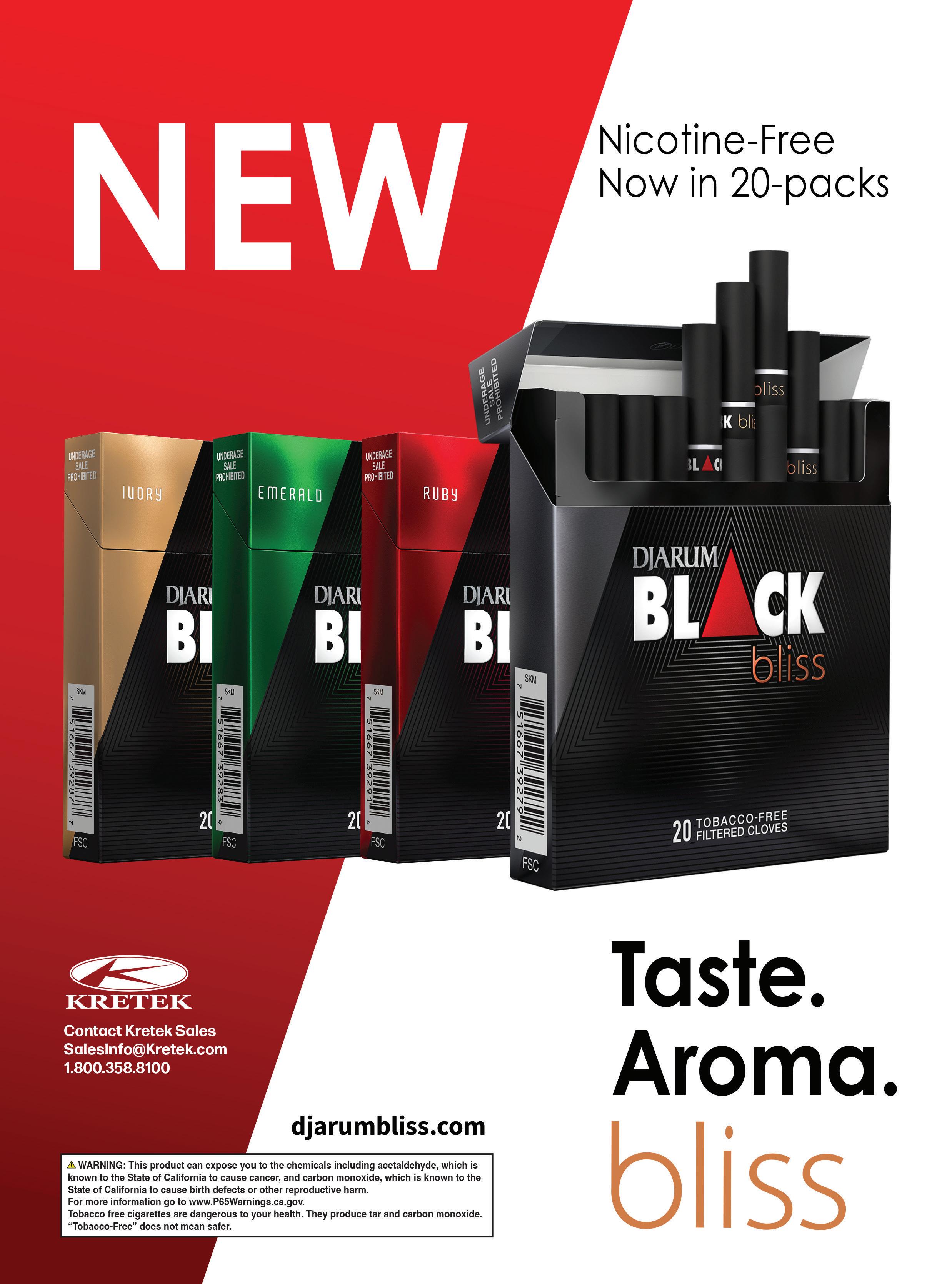
choose from a number of country-style sides like corn, green beans, pasta salad and butter potatoes. Prasek’s even offers gourmet cheeses and 27 different kinds of jerky.
Aside from its fresh and smoked meat options, Prasek’s provides its customers with numerous baked good options to choose from. However, its No. 1 seller is its kolache.

“Since we have a dense population of German and Czech heritage, we offer different flavors of kolache, including fruit- and cheese-filled ones,” said Korenek. “We also offer freshly made pigs in a blanket, cinnamon rolls, breakfast sandwiches, biscuits, pies and strudels.”
While Prasek’s focuses on providing smoked meat, fresh meat, barbecue and baked goods, consumers can still purchase grab-and-go items found in most c-stores.
“We do not offer bean-to-cup coffee machines, but we do offer coffee that is brewed fresh every day,” said Stoner. “We also have the option to make cappuccino, along with other coffee flavors, fountain drinks and ICEE.”

“One of the things we like to brag about our coffee program is we buy it from a local roaster in Houston. Our coffee beans are roasted so fresh that most of the time when it comes in a box, they are still warm,” added Korenek.
Stoner also mentioned that Prasek’s is known for its
sweet tea, which currently has its own billboard.
“We even have a selection of wine to choose from, along with our standard c-store beverages, including beer, water and other bottled drinks,” she said.
In terms of takeout, Prasek’s gives customers the option to order ahead and pick up inside the smokehouse.
“We like to tell people there is no order too big. If you need 200 cinnamon rolls from the bakery made fresh, just give us a couple of days’ notice, and we can take care of that order,” said Stoner.
Prasek’s is constantly looking for ways to improve its locations and brand, whether it’s potentially adding a loyalty program or eventually building new sites. Nonetheless, the main aspect Prasek’s is focusing on moving forward is expanding its brand so others can enjoy all of the fresh products it has to offer.
“Right now, we are in a brand awareness growth mode,” said Korenek. “We are distributing our products to over 1,000 different locations throughout Texas, Florida and the Midwest. We want to eventually offer our products in other states.”
Korenek also mentioned the possibility of opening smaller locations in urban areas in the years to come.
“Since both of our locations right now are in rural areas, we hope to eventually open Prasek’s smokehouses in more urban areas,” he said. “We just want to capitalize on what we have and what we know in a more urban setting.”
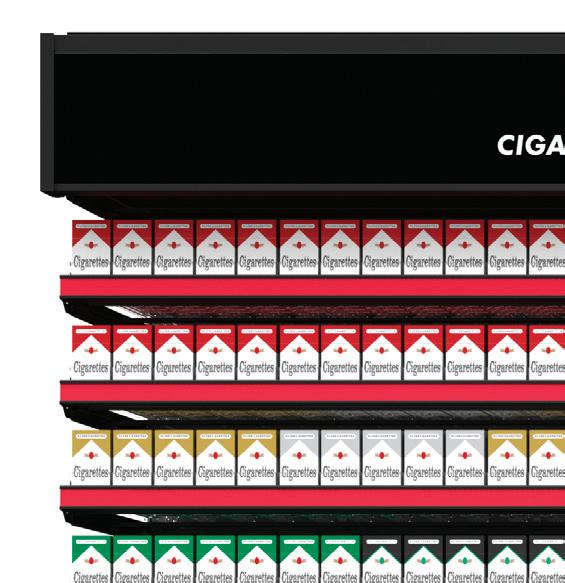











As Dash In focuses on its goal of creating “better experiences” for guests, employees and its communities, it’s implementing diversity, equity and inclusion practices, including two inaugural employee research groups.
Erin Del Conte • Editor-in-Chief
that says, “We grow and become leaders in our markets by delivering better experiences for our customers, each other and our communities.” To deliver better experiences we must know what our stakeholders value. (We also must) acknowledge who they are, understand their needs and experiences, learn what motivates and inspires them, and work together toward goal alignment. We try not to think of it as an “initiative,” but more a lasting cultural norm — a way of being, a way of working, a way of doing business and a way of engaging with our communities.
CStore Decisions caught up with Rayma Alexander, director of corporate communications & DEI for The Wills Group, to learn more about how the company is approaching DEI across its network. Dash In operates 55 stores — 41 franchise locations and 14 company-operated sites in Maryland, Virginia and Delaware. The Wills Group has another 225 locations that operate under the legacy gas station model; including Shell, Exxon and other major oil brands.

CStore Decisions (CSD): Why is DEI an important initiative for Dash In?
Rayma Alexander (RA): For us it all starts with what we call “The Simple Plan.” It’s our internal doctrine
CSD: How is Dash In approaching DEI today?
RA: The Wills Group and family of companies, Dash In, Splash In and SMO Motor Fuels, all operate under a single promise and intention.

Statement: At The Wills Group and our family of businesses, including Dash In, Splash In and SMO Motor Fuels, diversity and inclusion is core to achieving our mission of being the preferred choice for employees, customers and business partners in our chosen markets and geographies.
Promise: Our teams reflect the diverse communities we serve. We embrace the uniqueness of individuals and support equitable opportunities and belonging for all, leveraging employee voices in our
The Wills Group, the parent company of Dash In convenience stores, is working toward making diversity, equity and inclusion (DEI) a way of life for the chain, embedding DEI practices into the chain’s culture from the way it does business to how it serves communities.





















































































































































































business processes to deliver products, services and experiences that exceed our customers’ expectations.
Add to that a planned learning curriculum that includes courses like: The Business Case for Diversity and Inclusion; Managing Inclusion, Inclusive Leadership and Microaggressions. These trainings are biannual and offered with the intent of keeping DEI topics fresh and actionable.
CSD: I understand Dash In is starting employee resource groups. What are these, how are they beneficial and how do they work?
RA: The Wills Group and Dash In have already launched our two inaugural employee resource groups (ERGs). We held a session to help our employees understand the value of ERGs — affinity, personal and professional growth, business support, community outreach — and then we left it to them to decide which ERGs they wanted. They chose what is now Women of Wills (Professional Women) and Families in Motion, just as it sounds. They establish their own mission, vision and goals and are provided a budget to help execute.
We also have a Diversity Council, which meets a couple of times a year. It includes: the ERG officer teams, a DEI advisor, the executive vice president of talent and people operations, myself, and the president and chief operating officer. We review progress, policies and practices, and discuss challenges and opportunities as a group.
CSD: Dash In has been designated a Best Places to Work. How important is a diversity, equity and inclusion focus to being able to resonate with employees today? Is this something you think chains need to have? Why or why not?
RA: Yes, we have attained Great Place to Work (GPTW) certification for two years in a row now. We are immensely proud of this designation and the positive way it resonates with employees, potential hires, customers and our neighbors. What’s great about it is the submission process makes us introspect and take inventory of all the things we are doing for our employees. For us, richer benefits, a DEI learning track, diversity hiring and community engagement all make positive impacts. Absolutely,
it’s important to truly embrace diversity, equity and inclusion. It adds so much more depth to employee and community engagement, decision-making and the customer experience.
CSD: From an employee retention and satisfaction perspective, how is a focus on DEI making a difference at Dash In?
RA: Our employees know that we have something special going on at the company. That we are embracing DEI and holding ourselves accountable with things like the annual GPTW certification and our intention with diversity hiring and community engagement. Just the fact that I was brought in to lead this effort at The Wills Group and Dash In says something.
CSD: What are Dash In’s DEI goals going forward?
RA: We want to continue to be intentional in our hiring, promotion, learning and inclusion practices with a keen focus on culture, talent, communities and clients, such that good DEI practices are fully embedded into our culture, practices and actions naturally. We believe we are better when we celebrate differences and leverage them to grow as a team and a company.
CSD: What advice do you have for other chains interested in DEI programs?
RA: Do your research. Start by taking time to listen to your people at every level of the organization. Bring in neutral experts and DEI leaders to help you understand your talent flow, your customer proposition and your DEI opportunities. Be open-minded, patient and courageous. Take your employees on the journey with you.
CSD: For any c-store chain listening that is interested in doing more around diversity, equity and inclusion, where would you recommend they start?

RA: Gain buy-in in the C-suite. Influencers and decision-makers need to work together. Make the investment, and hire a consultant to guide your efforts initially. They will help you gain perspective and chart a course for DEI success that fits your organization. At the end of the day, it’s about advancing humanity and inclusion and equity for all.








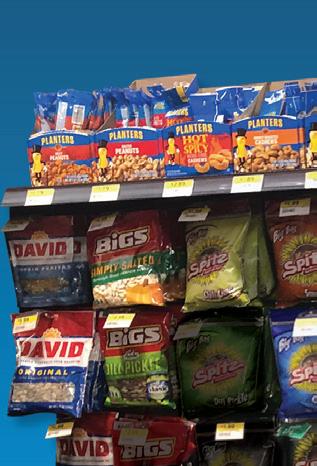

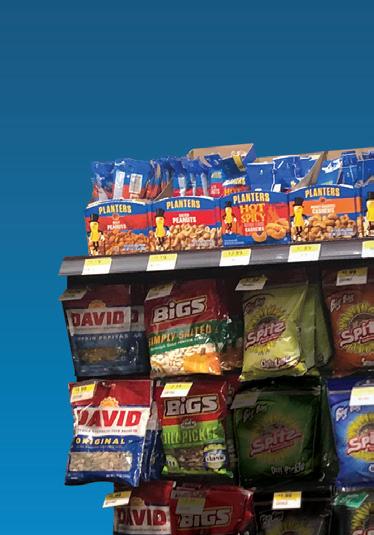


® Tray Merchandising
Our revolutionary Tray and WonderBar Merchandising System is designed and manufactured with the most innovative accessories to increase facings, maximize visibility, enhance package billboarding, ensure product rotation, and reduce shrinkage for a full range of frozen, refrigerated and general merchandise products. Easy to install and adjust, this complete merchandising system also ensures quick restocking.
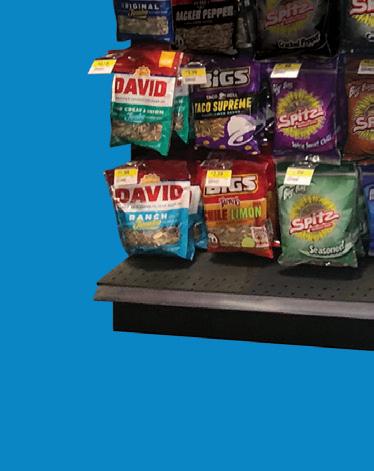
Radius or Square Tray Sidewalls












Trion will help you optimize your display space, attract customers, increase sales and cut labor costs—and our products are built to last. No wonder we’re the industry’s leading manufacturer and supplier, with more than 16 million trays earning high praise from retailers and shoppers every day!






—
WonderBar ®








Tray Merchandising

n Increases facings by 20% to 35% in many categories.
Automatically billboards and faces product.




n Automatically billboards and faces product.
n Reduces losses from bag hook tearout.

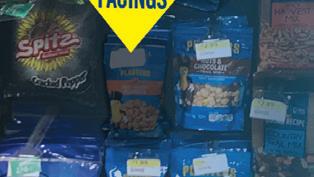



n Allows rear restocking and proper date rotation.
™
MODERNIZE YOU R MERCHANDISING — SELL MORE IN THE SAME SPA YOUR ™
n Dramatically increases sales in the same space.








Dramatically increases sales in the same space. Adjusts to accommodate various package widths. 3






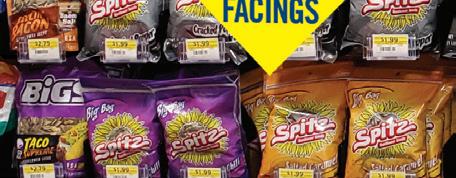








When it comes to impulse buying, imagine how a substantial gain in product variety can boost sales. By enabling you to display hooked and tray packages as well as tall, wide and heavy products — WonderBar® helps you maximize the graphic impact of manufacturers’ colorful package designs.

n Dual lane tray accepts two narrow items for side-by-side merchandising.
n Specialized front stops add support.
n Seamlessly integrate signage into your display for better presentation and navigation.
n Reduced losses from bag hook tearout.
n Adds 25-35% more product in 12' set.
n Draw traffic to center aisle candy.
n Great for large lay-down bags, gum, gusseted bags, large family packs, candy bars, licorice, novelty candy, theatre packs and specially packed seasonal favorites.
n Consistently better product presentation with less labor time spent facing.
With the WonderBar® Tray and Bar Merchandising System, now you can bring related products neatly together like bagged salad, dressing and bacon bits in ways not previously possible. Fit many more items, sell families of products in different sizes and increase impulse buying with cross-sells and adjacencies.

n Dual lane tray accepts two narrow items for side-by-side merchandising.
n Unique design features separate paddles to push each lane forward individually.
n Asymmetrical lanes sell different-width products. Great for cross merchandising.
n Each lane adjusts to fit products as small as 1¾" wide.
n Mini and Standard width trays available. Mini adjusts from 3 3/8" to 6 1/2" wide and Standard adjusts from 5 1/2" to 8" wide.
Trion’s double-wide, adjustable tray expands beyond 17" to handle even your largest round, square and rectangular packages. With dual pushers and up to six heavy-duty springs, this tray empowers you to keep the heaviest products moving smoothly day after day, year after year.
n Optimally display round and square pizzas, family packs and multipack entrées.

n Maximize display space.
n Adjusts for packages from 10½" to 17½".
n Dual pushers ensure an even, steady push to the front of the tray.
n Heavy-duty construction.
n Easy to install, adapt and restock.
Trion’s WonderBar® solutions keep round, oval, loaf, square sliced meats and bologna optimally faced for enhanced shopability, easy product rotation, added freshness and reduced shrinkage loss. A wide range of depths, widths and package capabilities give you a strong competitive edge for all your refrigerated retailing.

n Ideal for bologna, bacon, hot dogs, tub meats, sausage, pepperoni and Lunchables.®
n Innovative bologna tray design solves inadvertent popout when first package is dispensed.
n Increase 6 rows / 42 facings to 7 rows / 49 facings in typical 4' set.
n Designed for easy stocking & re-planogramming.
n Optional locking pusher paddle.
n Trays lift out for rear loading.
n Unique baffle system ensures optimal air flow in open front coolers.
n Heavy-duty construction.
Nothing attracts shoppers better than fresh produce, and nothing displays refrigerated produce better than Trion’s Tray and Bar Merchandising System. Face more packages, accommodate a wider range of shapes and sizes, restock easily, and manage dated produce better.

n Air flow baffles maintain optimal product temperature and extend shelf life.

n Trays lift out for rear restocking and proper rotation.
n Versatile spring tension is gentle on delicate produce.
n Handles regular bags, pillow packs and gusseted bags.
n Space gains allow better cross-merchandising.
n Long-life, durable cooler-capable steel construction.
n Add rows of additional product.
The WonderBar® Tray and Bar Merchandising System is the new face of cheese and fresh pasta. Shredded, blocks, cubed, sliced, string and individually wrapped you name it, we tame it. Never before has it been this easy to billboard these delicate products, improve their rotation and reduce their shrinkage.

n The total bar solution for hooked and bagged items and tray displays.
n Typically adds 2 rows of product; optimizes merchandising space.
n Trays lift out for rear restocking and proper rotation.
n Air flow baffles maintain optimal product temperature and extend shelf life.

Trion improves shoppers’ perception of frozen foods, increases the amount of product on display, saves energy, and makes stocking, resetting and re-planogramming a breeze. By withstanding the demands of cold environments, our freezer-friendly system and materials have proven reliability. And, when your frozen foods are consistently billboarded in a tray, you’ll experience less product loss in back compared to shelves.


n Keeps entrées, dinners, bagged and boxed vegetables, novelties and large packages upright, faced and billboarded.
n Gain 12-17% product per door.
n Save 1-1½ hours of labor per day facing product.
n Better visibility and shopability; reduces door openings by 25% and saves energy.
Only Trion WonderBar® offers one solution that enables you to consistently face and easily stock virtually any product— hardware, soft goods, coffee, dry goods, air fresheners, light bulbs, pet treats and anything else your customers demand — and increase sales for any category.


n Full range of bars, trays, hook styles, pushers, spring tensions, label holders and signs adapt to any product, any size, storewide.
n Wire trays for shelf use available.
n Hybrid locking anti-sweep hook deters theft.
n Adjustable tray width addresses the demands of bags, boxes, clamshells, blister packs and oversize packages.

Simple design allows for one man installation. Universal Mounts quickly fit into both thick- and thin-walled gondolas, coolers and freezers.
WonderBar is compatible with most existing bar merchandising systems, bar shapes, and tool-free as well as threaded fastener mounts. Available in 30," 3' and 4' lengths.
Bar adjusts in 1" vertical increments for tool-free and threaded fastener systems. Saddle mount trays and hooks easily and infinitely adjust horizontally along the bar.
Includes pusher trays, saddle hooks, airflow baffle systems, adjustable labeling and sign options. Upgrade to plug-in hooks and label systems.
As many as 7 standard tray depths ranging from 13" to 24" to fit your exact merchandising needs. Plus custom trays and tray depths are available.
Trays adapt to fit the width of virtually all products and package styles with Oversize, Standard, Dual and Mini Trays accommodating lane widths from 1 3/ 4" to 17 1/ 2."
Metal-sidewall Bar Trays include front and rear anti-skid pads already installed, can be used directly on shelves and can be swapped from bar to shelf as needed.
Trion’s innovative solution keeps round, oval, loaf and square sliced meats and bologna faced and prevents popout of nested packages.
Dual Lane tray accepts two narrow items and allows them to be pushed forward individually. Each lane adjusts to fit products as small as 13/4" wide. Mini & Standard width trays available.
Two pushers keep large products of any shape forward & optimally faced. Trays can merchandise products from 10 1/ 2" to 17 1/ 2" wide.

Instant lift-out trays speed planogram changes and re-merchandising. Reset up to 48 facings in as little as 15 minutes. Easily create new cross-sells.
Horizontal & Vertical Sign holder systems allow easy categorization & promotion of products. Features an alignment bridge insuring consistent presentation across long displays.
Tray Label Holders are available to support drop-in, slide-in, and promo clip bib tag labels. All Holders snap directly to the front of all tray styles and sizes.
Six spring tensions and up to three mount positions in Standard Trays allow multiple combinations to fine tune push strength to any package style or product weight.
A range of standard product stops address your every need with special solutions and adaptors for more demanding package sizes and shapes.
Enhanced functionality with numerous standard pusher paddle sizes up to 6 3/4" tall, dual paddle configurations possible for Oversize and Dual Lane Trays. Imprinted paddles available.
Variety of sizes for all product heights. Features a built-in 2 1/2" x 11/2"recessed label holder. Dual paddle configurations possible for Oversize and Dual. Handles heavier product. Cooler & Freezer capable.
Fits standard size tray with pusher paddle height of 5". Optional locking pusher paddles will not lock without being engaged by user. Cooler & Freezer capable.
Minimize shrink, radically cut stocking labor, and guarantee freshness and customer satisfaction with easy lift-out trays. Load new stock at the back of the tray to insure proper product rotation.
Sidewall Extenders quickly snap-on to standard metal sidewalls to create taller lanes, better contain tall or oversize packages, and corral stacked items.
n Depth: 13" to 24"
n Adjustable width: 1¾" to 17½"
Radius or square Bar and shelf capable
n Open wire available for shelf placement
n Swap from Shelf to Bar
n Auto feed any product
n Molded pusher paddle available, both locking and non-locking styles

n Integrated signing capability
n Bridge for seamless long display
n Multiple spring/mount locations and dual-spring capability fine-tune push strength
n Integrated slide-in, drop-in and promo-clip label holders

Hooks
n Saddle-mount, anti-theft, pusher, plug-in and custom styles
n Integrate anywhere vertically within tray displays
Each component in Trion’s WonderBar ® Tray and Bar Merchandising System is designed for performance, durability, compatibility and ease of installation. Made from U.S. steel and heavy-duty wire frames, this versatile array of components will be faithfully pushing your products for many productive years to come.
n Range of heights and widths
gravity feed pouch hooks
Bars
n Lengths: 30," 3' or 4' and custom
n Saddle-mount or plug-in
n Retrofits major systems
n Tool-free installation, threaded mounts available


n Vertical 1" adjustability
n Specialized designs for round, square and oval tubs; all size bags and pillow packs; gusseted bags; boxes; bottles; clam shells; blister packs; and tall, narrow, small and/or oversize packaging.
n Radius or square metal sidewalls
n Bar and shelf capable
n Open wire sidewalls available for shelf placement

n Swap readily from Shelf to Bar as needed
n Auto feed any product
n Molded pusher paddle available, both locking and non-locking styles
©2023 Patents and patents pending. Product photography is a simulation of a retail environment and is not meant to imply endorsement by or for any brand or manufacturer.
The Deloitte Grocery Retail Executive survey asked,"What will grocery shopping be like for your customers in the next five to 10 years?" Top responses included:

Now that consumers are spending more money while shopping, due to inflation, they are relying on store brands when making purchases. 84.51° recently noted:
31% of consumers reported a strong store brand preference, while only 8% said they strongly preferred the national brand.
16% said they prefer the store brand but are open to national brands, while 29% said they like the national brand but are open to store brand.

17% reported no preference either way.
Source: 84.51°, August 2023

Based on 84.51°'s July Consumer Digest, items that shoppers are most likely to purchase during their shopping trip include:
Source: Deloitte’s Grocery Retail Executive Survey, August 2023
More consumers are using delivery services when shopping because it's convenient. However, using delivery services is starting to cost consumers more money. LendingTree's most recent survey stated that:

82% of Americans have used delivery services in the past year, spending an average of $407 a month on them. The most popular services are retail (54%), food (42%) and grocery delivery (34%)
65% of users agree they're willing to spend extra money to save time.

44% admit to spending more than they can afford on these services, with 27% doing so this past year.
68% of those who use these services believe there should be a minimum wage for delivery workers.
79% say they tip for convenience services when it's an option.




Source: LendingTree, August 2023

45% Produce
60% Ice Cream/Novelties




63% Fresh Bakery
67% Snacks/Candy
Source: 84.51 °'s July Consumer Digest



When it's time to shop, consumers look at product reviews before purchasing. As stated in PowerReviews' most recent survey of 17,500 grocery shoppers:
94% of shoppers reported reading ratings and reviews at least occasionally when shopping for groceries online, up from 90% in 2022 and 82% in 2021.
90% of consumers say they're more likely to purchase a grocery item for the first time if there are customer reviews available for it — up from 83% in 2022.
63% of online grocery shoppers pay attention to the volume of reviews for a product; 50% want to consult customers' questions and answers, 47% want customer-submitted imagery, and 24% want customer-submitted videos.
Source: PowerReview, July 2023
Consumers' spending habits are slowly returning to normal as shoppers spend more money on products they want, whether in-store, online or through delivery apps.

Fresh off its 24th acquisition, ARKO Corp., led by CEO Arie Kotler, earmarks over $2 billion for continued mergers and acquisitions (M&A) growth as it integrates recently purchased chains into its portfolio.
Erin Del Conte • Editor-in-ChiefARKO Corp., the parent company of c-store behemoth GPM Investments LLC, has been on a mergers and acquisitions (M&A) roll, aggressively growing its fleet of c-stores from 200 sites to nearly 1,550 locations over the past 10 years.

At the end of June, the company closed on its 24th acquisition since 2013. In 2023 alone, ARKO has added 159 company-operated c-stores to its portfolio through two major acquisitions.
Now, ARKO has its sights set on future growth as it folds its latest acquisitions into its portfolio. As it brings new chains under its umbrella, ARKO is focused on three key pillars: 1.) Focusing on core destination categories, such as candy, packaged beverages, salty snacks, packaged sweet snacks and beer; 2.) Leveraging its fas REWARDS loyalty program; and 3.) Expanding the foodservice and beverage offerings in its stores.
ARKO’s wholly owned subsidiary GPM Investments, the sixth-largest c-store chain in the U.S., operates in 33 states and Washington, D.C. Its more than 1,500 company-operated stores are comprised of more than 25 regional brands that have existed in their markets for an average of about 50 years. The company also supplies fuel to more than 1,800 dealer locations and operates 293 cardlock locations.
GPM, based in Richmond, Va., was founded in 2002 with 169 company-operated stores.
ARKO Holdings Ltd., under the leadership of Chairman, President and CEO Arie Kotler, acquired control of GPM in 2011. By 2013, GPM operated more than 200 Fas Mart and Shore Stop locations in Connecticut, Delaware, Maryland, North Carolina, Pennsylvania, Tennessee and Virginia.
In August 2013, ARKO Holdings began spearheading GPM’s growth path through acquisitions, starting with the purchase of 263 stores from VPS Convenience Store Group. The stores were located in North Carolina, South Carolina, Tennessee and Virginia, and included the brand names Scotchman, Young’s, Li’l Cricket, Quick & Easy Everyday Shop & Café, BreadBox and Cigarette City. The company continued to expand through acquisitions from there.
In 2020, ARKO Holdings Ltd. combined with Haymaker Acquisition Corp., a special purpose acquisition company, to become ARKO Corp., a publicly traded company on the Nasdaq Stock Market.
The company operates in four reportable segments: 1.) retail, which includes fuel and merchandise sales to retail consumers; 2.) wholesale, which in-
cludes supplying fuel to third-party dealers and consignment agents; 3.) GPM Petroleum, which sells and supplies fuel to GPM’s retail and wholesale sites; and 4.) Fleet fueling, which operates proprietary and thirdparty cardlock locations (unstaffed fuel locations) and issues proprietary fuel cards to provide customers access to a nationwide network of fueling sites.
In 2022, which marked ARKO’s second year as a public company, ARKO ranked 498 on the 2022 Fortune 500 list, which lists the largest companies by total revenue in the U.S. In 2023, ARKO again ranked on the Fortune 500 list at No. 460, moving up 38 places.
In 2022, ARKO secured a real property program agreement with Oak Street Real Estate Capital and announced four planned acquisitions: Quarles Petroleum and Pride Convenience Holdings, which both closed in 2022; Transit Energy Group (TEG), which closed in March 2023; and WTG Fuel Holdings, which closed in June 2023.

The purchase price for all four acquisitions totaled approximately $906 million, for which ARKO contributed just over $200 million.
In 2023, the company amended the Oak Street agreement, which extended the term through September 2024 and provided up to $1.5 billion in new funding.
“This was a very active 12 months. I think 2022 was the first year that we did four acquisitions in such a short order,” said ARKO’s CEO Arie Kotler. “We have a great team of people. In all of the acquisitions, we hired most of the people who worked for


































































































those companies, and I’m very proud about that. We are adding more people. Today, all together, we have approximately 14,000 employees.”
The acquisition of Fredericksburg, Va.-based Quarles’ fleet fueling business closed in July 2022 and both complemented and grew ARKO’s core wholesale strategy, adding a mature fleet fueling platform and adding to its supply and distribution capabilities. Quarles represents the largest fleet fueling cardlock operator on the East Coast, with operations in Virginia, North Carolina, Maryland, Pennsylvania and Washington, D.C. The purchase included 121 proprietary and 64 third-party cardlock sites, which are unmanned fuel sites where customers buy fuel using fleet cards. The sites are situated on high-traffic corridors in the Mid-Atlantic region.
“Quarles was a very unique acquisition. It was a (nearly) 85-year-old company with an excellent operation,” Kotler said. “Quarles is one of the best operators, I will say, probably in the country, that I met. … And given their expertise, we felt that this was a great add-on to our company.”
Next, ARKO acquired Pride, with 31 c-stores in Connecticut and Massachusetts, for approximately $230 million, including the value of cash and inventory, in December 2022. Pride is known regionally for its fresh foodservice program and features many large-format stores, including two high-volume travel centers. At the time of the acquisition, Pride had recently broken ground on a new-to-industry (NTI) travel center in South Windsor, Conn.

The NTI Pride Travel Center measures 4,860 square
feet and opened on June 30, 2023. It features a Chester’s Chicken, a proprietary food offering, a drive-through, 12 fuel pumps, four diesel pumps and 10 high-flow diesel pumps.
The TEG acquisition, which closed in March 2023, added approximately 135 company-operated convenience stores and 181 wholesale sites, among other assets, to ARKO’s portfolio for $370 million, plus the value of inventory, and expanded the chain’s southern retail territory into Alabama and Mississippi. TEG brought new banners to ARKO such as Corner Mart, Dixie Mart, Flash Market, Market Express and Rose Mart. It also brought a transportation business with 58 trucks and 78 tanker trailers that supports the retail and wholesale business in the Southeastern U.S.
“TEG is another add-on in markets where we do business and in markets that are very close to markets where we do business. From an economy of scale standpoint, it was a great opportunity for us,” Kotler said.
ARKO closed the WTG acquisition in June 2023 for approximately $140 million, plus the value of inventory. The acquisition enhanced the company’s footprint in the Permian Basin market, with 24 companyoperated Uncle’s Convenience Stores across western Texas. The acquisition also included 68 proprietary GASCARD-branded fleet fueling cardlock sites and 43 private cardlock sites — one of the biggest fleet fueling operations in West Texas — as well as three parcels of land and nine independent dealer locations.
“This is another opportunity for us to expose ourselves to the customers that are visiting cardlocks,” Kotler added.
• Establishes a digital foundation to optimize the ATCs 21+ journey

• Enables an integrated marketing approach for your ATCs 21+
• Provides a clear road map for development, integration, and implementation supported by AGDC

Help responsibly connect & engage with your ATCs 21+ in the digital environment


Invest in digital infrastructure that responsibly optimizes & enables new channels for ATCs 21+ experiences

Enhance your retail digital capabilities & build a foundation of responsibility to meet the evolving ATCs 21+ expectations & improve their experiences


As ARKO integrates stores, it’s completing functional remodels, bringing stores into alignment from a merchandising and marketing standpoint.
As ARKO’s c-store business grows, its strategy is to acquire local, usually family-owned chains with long histories in their communities and substantial brand equity.
“We are in a lot of small towns,” Kotler said. “We are in a lot of rural markets, secondary markets. If you’re looking at our demographic, 40% of our retail stores are in towns that have 20,000 people or less.”
Especially in these small towns, the c-stores might be the go-to place for groceries and other products and are well known.
When ARKO acquires chains, it retains the banner names, which are familiar to the community and have meaning to their customer base.
However, when closing on particularly small acquisitions in areas where it has strong brands already entrenched, ARKO might convert the brand name to one of its well-known brands in the area.
“For example, we did a small acquisition in the Carolinas that included eight stores,” Kotler said. “One of the brands … that we have over there is called Scotchman — an over 50-year-old brand. And what we did, we converted some of those stores that we bought to the Scotchman brand because it’s a brand that customers recognize in this market.”
And make no mistake, ARKO isn’t about to pause its acquisition streak. It’s targeting continued expansion for the foreseeable future.
“Our plan is to continue to grow. We have a highly experienced team that works in-house on mergers and acquisitions,” Kotler said.
Meanwhile, ARKO is also focused on resetting its newly acquired stores, adding a larger product assortment and new promotions, and integrating the sites with its fas REWARDS loyalty program.
As ARKO integrates stores, it’s completing what it calls functional remodels of the locations, bringing the stores into alignment from a merchandising and marketing standpoint.

The move marks a shift in strategy for the chain, which in 2021 announced plans to invest $360 million over three to five years to bring 360 stores under a unified design. But when construction and supply costs skyrocketed some 40-50% post-pandemic, rather than wait for prices to come down, ARKO decided to focus on unifying the core offerings inside the stores through functional remodels.
“The idea is really what can we do inside the box, inside the store, for our customers versus just sit and wait just for a full remodel,” Kotler said.
Because ARKO usually leaves store banner names in place, it doesn’t change the façade of most stores.
“We usually go inside and try to planogram them in a way that most of our stores are being planogrammed,” Kotler said.
After the Pride acquisition, for example, it added more than 1,000 items to the stores.
“Given our size, economy of scale and our team behind the scenes, we use data and understand what exactly the customer is looking for,” Kotler said. “When I say, ‘added 1,000 items,’ it’s not that the store didn’t have any items, it’s just a matter of we added the right items. We are really trying to make sure we have the right assortment and the right product that the customers are looking for.”
As ARKO tweaks store assortment, it’s focused on its core destination categories, including candy, packaged beverages, salty snacks, packaged sweet snacks and beer. ARKO has been working to increase merchandise gross profit while decreasing its reliance on cigarettes. Since 2020, ARKO reduced its cigarette concentration from 38% to 29%, Kotler noted. The change meant it was able to offer other products to customers.
As ARKO has executed this strategy, its core destination categories, as a percentage of total merchandise sales, have increased from 38.4% in Q2 2020 to 44.6% in Q2 2023, according to the company’s 2023 Second Quarter Earnings Report. Same-store sales excluding cigarettes saw a 3.8% increase in Q2 2023 over Q2 2022.


































































































One of ARKO’s key focus areas is expanding the food and beverage presence in its stores.
“We grew our same-store sales excluding cigarettes almost 4.6% on average over the past three years,” Kotler said. “And the reason I mention sales excluding cigarettes is because at the end of the day, the core business, it’s not cigarettes.”
Instead, ARKO sees its core business shifting to its destination categories and foodservice.
Another key change ARKO makes to stores is updating the pricing on all products to better appeal to shoppers.
“Our attractive pricing attracts the customers in the markets where we do business,” Kotler said. ARKO is also making big investments in equipment upgrades to help sites put their best foot forward on foodservice.
By the end of Q2 2023, ARKO had added beanto-cup coffee machines to more than 700 stores. So far bean-to-cup machines have already rolled out to the Pride locations, and ARKO is in the process of finalizing the bean-to-cup rollout at the TEG sites. WTG is set to follow. As it completes these rollouts it plans to add another 230 bean-to-cup machines by the end of 2023, for a total of 930 machines.

The company also has 160-plus hot grab-and-go units, 1,200 cold grab-and-go units, 700 freezers and 370-plus roller grills at the stores, with plans to add another 120 roller grills by the end of the year.
With ARKO’s model and expertise it can operate between 1,000- and 6,000-square-foot stores, Kotler explained. On average its sites measure between 2,500 to 3,000 square feet.
When it comes to the forecourt, ARKO is the third-largest Valero distributor in the country and has a relationship with all major gas brands.
“Different geographies have different supply dynamics. Having strong agreements with all of the major oil companies allows us to be very competitive,” Kotler said.
ARKO is investing in electric vehicle (EV) charging in areas where it sees an increase in EV penetration. Today, ARKO operates 15 EV charging locations totaling 62 charging ports across nine states and is set to launch another 24 EV charging sites by the end of 2024.
“We are moving with the market,” he said. ARKO plans to pursue any grants or subsidies available.
“Any market that we see an increase in EV penetration, we will assess the feasibility of adding a charging location,” Kotler said. ARKO is also working to ensure it features robust foodservice offerings at locations that feature EV charging.
While the core of ARKO’s strategy is acquisitions, it’s also taking advantage of opportunities to build NTI stores.
In addition to the Pride Travel Center that opened in June, in 2021 ARKO razed and rebuilt a Scotchman store in Rock Hill, S.C., that now measures nearly 5,700 square feet.
The company has other NTI stores “in the works right now in different stages of planning,” Kotler said.
ARKO is focused on growing its proprietary foodservice offerings, including pizza, chicken and prepared sandwiches, roller grill and dispensed beverages, identifying the price points that resonate with customers across the menu. It’s also expanding its frozen food offering.









“There’s a lot of effort being put together into the foodservice category right now,” Kotler said. “This is probably one of our biggest opportunities.”
After scaling the company rapidly over the past 10 years, ARKO is now turning its focus to developing a food offering that resonates with customers.
“We are actually peeling the onion right now. The opportunity for us is to spend more time in the stores, bring more fresh food offerings into our stores,” Kotler said.
Today, some 160-plus sites feature full-service delis that feature chicken, pizza and vegetables. ARKO also features 150-plus branded food franchise programs, including Dunkin’ and Subway. It offers a combination of proprietary and co-branded pizza programs in 200 stores.

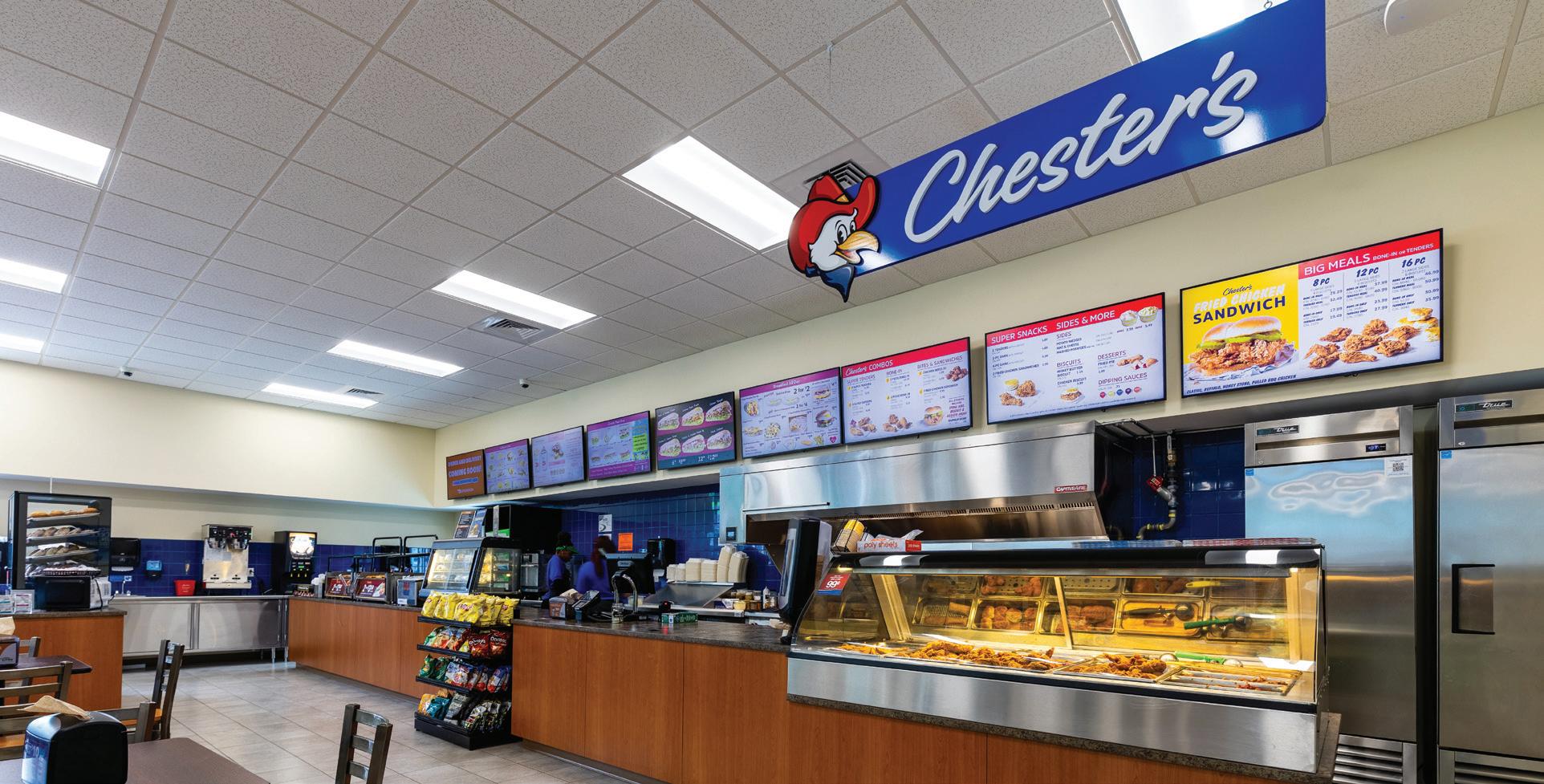
The addition of the bean-to-cup coffee machines allows ARKO to sell fresh coffee 24/7.
“Since we did that, we have grown our coffee business substantially, especially with loyal customers. Loyal customers can come to the store today and they can buy coffee for 99 cents,” he said.
The company’s efforts are paying off. ARKO has seen a 13.4% year-over-year increase in retail graband-go sales in Q2 2023 as compared to Q2 2022 on a same-store basis.
Drive-through has not been a focus for ARKO, since it mainly focuses on acquisitions and hasn’t
ARKO’s wholly owned subsidiary GPM Investments operates in 33 states and Washington, D.C. Its more than 1,500 company-operated stores are comprised of more than 25 regional brands that have existed in their markets for an average of about 50 years.

built NTI stores until recently. However, its most recent NTI site — the Pride Travel Center in South Windsor — features a drive-through, and many of the company’s Dunkin’ locations offer drive-throughs.
ARKO’s fleet of c-stores provides delivery through DoorDash as well as through its recently upgraded fas REWARDS app that offers various third-party delivery options.












































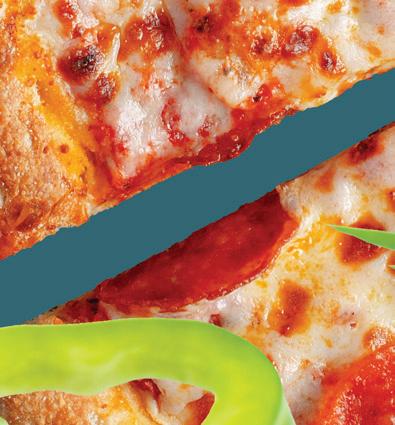





ARKO relaunched its fas REWARDS program in 2020, and this past March it upgraded its fas REWARDS app. The upgraded app includes memberonly “HOT deals” that aren’t available in stores, order and delivery, age-verified offers on tobacco and alcohol, a store locator with current gas prices, and a fas REWARDS dashboard where customers can monitor their rewards balance.
Today, ARKO boasts approximately 1.5 million enrolled fas REWARDS loyalty members and, as of July 31, had seen an increase of 205,234 enrolled, marketable members since relaunching the app in March.
ARKO’s 100 Days of Summer promotion, which kicked off on May 17, helped fuel the membership increase by giving customers $10 in “fas BUCKS” when they enrolled with their telephone number and correct email address. The program featured 16 unique deals on top of existing seasonal offerings — all for different limited times.
“You always need to figure out a way to engage more and more with your customers,” Kotler said. “We upgraded the app to make sure that we are communicating with our customers and providing them the different items they’re looking for.”
“For example, if you come to a store and you don’t buy fuel, we want to make sure that in the next purchase we are going to offer you some discount on fuel, so you become a fuel customer and vice versa,” he added.
ARKO found its loyalty members took about six times more trips per month than non-loyalty members and spent on average about $60 more per month during Q2 2023.
Looking ahead, ARKO has its sights set on continued expansion through acquisitions.
“Our DNA is M&A,” Kotler said. Still, ARKO is selective in the acquisition opportunities it pursues, he said.
As ARKO plans for continued growth, it reported as of June 30 more than $2 billion available for continued M&A funding, including $220 million cash on hand, approximately $602 million available under its credit lines, and up to $1.5 billion available from its amended Oak Street program agreement through September 2024.
“We are always looking to grow our base state by state by state. When we started, we started in seven states, and today we are in more than 30 states. We want to be consistent. We want to make sure that we are going to continue to grow through acquisitions,” Kotler said.
Kotler pointed out that ARKO has seen nearly 700% growth in company-operated store count over the past decade.
“We believe 2023 will be another year of strong performance and growth,” Kotler said. “We have a long runway for growth, and I am very proud of our continual progress as a company, executing our strategy of creating long-term shareholder value.”
Focusing on the three pillars — core destination categories, fas REWARDS, and food and beverage service — is a central part of the company’s expansion plans.
“The goal is to continue to grow, continue to invest money in our stores, continue to make sure we have the right offering within our stores and add more and more food and beverage offerings because … that is the No. 1 priority for us,” Kotler said.
“We are here to work with different chains, smaller chains, family chains. We are very unique,” Kotler said. “We usually not only keep their brand, we also keep their employees. We make sure that the chain that we are purchasing, that we’re keeping their legacy alive for many, many years.” CSD








Modern Store Equipment offers an unparalleled level of protection from theft with Secure Cooler and Secure Display. High power electromagnetic locks have the muscle to withstand hundreds of pounds of force per door. Access is easy with the swipe of a keycard or fob. The advanced app lets you program and control access from anywhere in the world 24/7. It’s easy to manage alcohol sales per your local laws with auto lock and unlock at the same time every day. Available on new cooler doors and can be retrofit on your existing cooler doors. Freestanding non-refrigerated displays available in 4 sizes.




C-store retailers eye seasonal opportunities this fall, as key candy segments enjoy dollar sales increases amid price hikes.
The pumpkin spice latte hails the unofficial onset of fall, but Halloween kicks off the holiday season, and convenience stores are in a prime position to gain sweet profits from the candy segment this time of year.




While some customers might not view cstores as the go-to channel for seasonal treats, the opportunity for convenience stores to capitalize on holiday candy sales continues to grow.
Consumers purchased, gifted and indulged in more than $22 billion worth of candy for Halloween, the winter holidays, Valentine’s Day and Easter in 2022, according to the National Confectioners Association’s (NCA) “State of Treating 2023” report.





Both gum and breath fresheners outperformed chocolate and candy in dollar and unit sales growth for the latest 52 weeks in the c-store channel, as prices surge.
In 2023, many c-store owners and category managers expect the upcoming holidays to further the momentum that’s been building throughout the year for many of the category’s brands.
Candy dollar sales have been trending upward, partly driven by price increases. Each of the four main product groups — chocolate, non-chocolate candy, gum and breath fresheners — posted dollar sales gains in c-stores over the past 52 weeks ending Aug. 13, according to market research firm Circana, a sign the segments have shed any lingering effects from the COVID-19 pandemic.
Gum and mints experienced more long-term reverberations from COVID-19 than many other candy offerings. As professionals continued to work from home or ease into a hybrid schedule, freshening one’s breath before meetings lost its value.
“Gum and mints were hit harder and have been slower to rebound. These products are often impulse buys and, with the reduction of foot traffic, in-store sales slowed,” said Lisa Olivares, a buyer for the Army & Air Force Exchange Service (AAFES). The retailer exclusively serves U.S. military personnel and their families on bases around the world and operates 10 distribution centers and more than 580 convenience stores.
Olivares also cited economic conditions such as inflation for customers pulling back on impulse buys. However, recent tallies pointed toward a
more positive shift for these two subcategories despite price bumps.
“The gum and mint category is bouncing back after seeing a drop-off during the COVID-19 pandemic. Sales started to come back in 2021, but (we) saw a stronger comeback in 2022,” said Carly Schildhaus, director of public affairs and communications for NCA.

Indeed, gum cashed in more than $1.1 billion in sales at c-stores over the 52 weeks ending Aug. 13, and unit sales climbed 6.1% in a year-over-year comparison, according to Circana. Breath fresheners also enjoyed sales gains, totaling more than $211 million and 4.5% growth in units.
Gum cashed in more than $1.1 billion in sales at c-stores, while breath fresheners also enjoyed sales gains, totaling more than $211 million.





























































































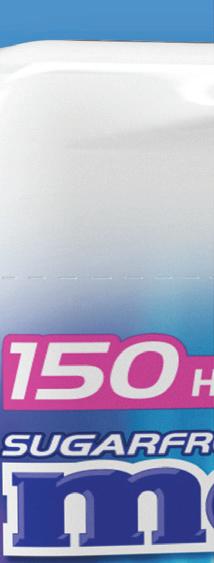































Chocolate is seeing greater competition from non-chocolate confections. Chocolate banked more than $3.6 billion while nonchocolate candy earned more than $3.3 billion.
Meanwhile, chocolate is seeing greater competition from non-chocolate confections — chocolate banked more than $3.6 billion while nonchocolate candy earned more than $3.3 billion. Both subcategories incurred losses in unit sales, but less so for non-chocolate candy, which registered greater dollar sales gains than chocolate.
“Non-chocolate continues to drive growth in confections,” said Olivares. “It is currently outpacing chocolate sales by 3% and is now almost 40% of total confection sales — a 7% growth in share from 2019 to 2023.”
Some of that increased market share at AAFES could be tied to the introduction of several new products. In addition to Vegobears, vegan gummy bears, Olivares mixed in a variety of new chewy treats, including Haribo Berry Clouds and Swedish Fish Blue Raspberry Lemonade. She also stocked a selection of novelty items, such as Push Pop Gummy Pop-its and Juicy Drop Gummy Dip ‘N Stix. Her chocolate planogram welcomed Twix Cookie Dough and Caramel Cold Brew M&Ms.
“Innovation is central to the confectionery industry — including gum and mints — with
manufacturers seeking to offer consumers their classic favorites alongside brand-new treating experiences,” said Schildhaus. In fact, NCA’s research shows a majority of consumers are curious about candy, gum and mint innovations and are willing to act on those impulses. More than 60% of people will occasionally or frequently look for new candy options.

Additional market trends shaping the category include customer interest in ingredient sourcing and benefits beyond indulgence, such as gum with functional benefits.
As the days count down to Halloween, c-stores expect customers to stock up on all kinds of candy bars, bubble gum and other sweets. The trick for retailers is to keep that interest in treats piqued throughout the holidays and beyond. CSD
• Gum cashed in more than $1.1 billion at c-stores over the 52 weeks ending Aug. 13, per Circana.
• More than 60% of people will occasionally or frequently look for new candy options, according to the National Confectioners Association.
• Breath fresheners posted 4.5% growth in unit sales at c-stores, according to Circana.

f’real has the ideal self-serve frozen beverage program for you with our B6 blender. Take a look at this solution and just picture the labor-savings!














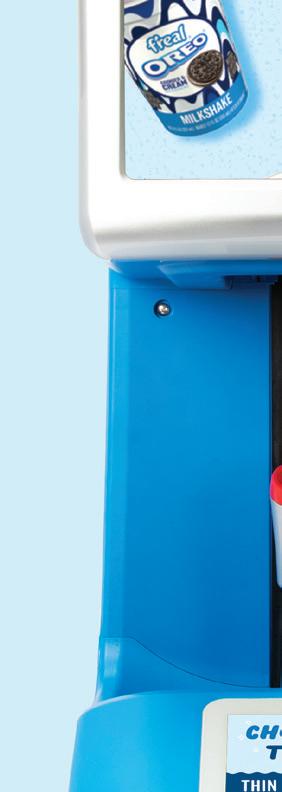


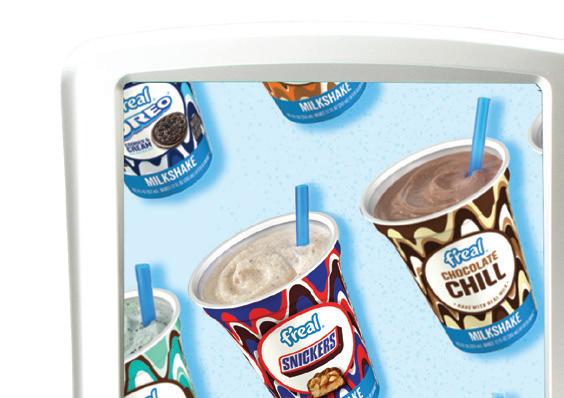

























f’real’s self-service program lets customers blend their own milkshakes and plant-based smoothies with the push of a button. Save on labor with this program since all you need to do is keep the freezer stocked and let your customers blend, sip, and chill. It’s really that easy!










Let your customers do the work. They select a mouthwatering milkshake or plant-based smoothie flavor from the freezer, place the selected treat in the cup holder of the blender, select their preferred thickness, and hit blend! In about a minute, they have a blended, customized, indulgent shake or smoothie ready-to-go.
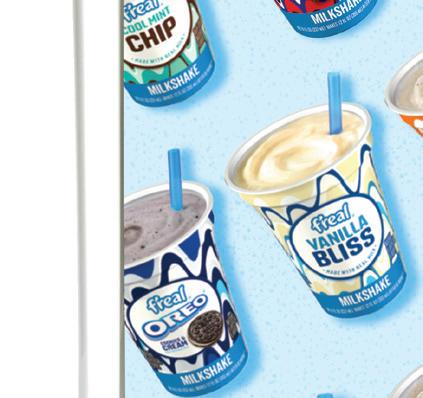
C-store retailers need to pay attention to emerging national trends as well as keep track of what their own customers are purchasing in the tobacco category to best utilize this segment of their store.
Emily Boes • Senior EditorDespite regulatory threats, tobacco remains one of the leading categories driving traffic inside c-stores, and bolstering sales for this evolving category is top of mind for many retailers.





“Success in maximizing tobacco sales revolves around having the right assortment and providing as much value as possible,” said Adam Long, senior category manager, The Rutter’s Cos.



The tobacco backbar at convenience stores is heavily influenced by FDA, state and local regulations, whether it be a statewide flavor ban or a marketing denial order on a vape product.










At press time, c-store retailers were still waiting for a finalized ruling from the FDA on a menthol and flavored cigar ban.



“In recent public comments, FDA Center for Products Director Brian King said that the final menthol rule will be published by the end of the year. In the final rule, it will likely have an effective date of one year later. This implementation could be further pushed out if there is litigation challenging the rule,” said David Spross, executive director of the National Association of Tobacco Outlets (NATO).





In addition to this, FDA has proposed a rule which would establish a maximum nicotine level. This proposed rule will be published after the final rule regarding menthol and flavored cigars is published. Spross noted that if there is also litigation, it could be years before it takes effect.

Curby’s, which has one site in Lubbock, Texas, but will potentially break ground on two more locations early in 2024, is not expecting these rulings to have an impact on sales or customer preferences as of this moment in time.

Love’s Travel Stops, however, with 644 locations in 42 states, has already seen sales drop in areas that implemented a ban and expects the trend to continue should a ban occur on the federal level.
“Customer preferences will have to adjust with regulations; they will not be allowed to purchase the items they traditionally did and will have to adjust if they want to consume nicotine,” said Victoria Sheppard, category manager, Love’s.











At The Rutter’s Cos., which operates 85 locations in Pennsylvania, Maryland and West Virginia, Long noted




As the price per unit increases across the board for tobacco, unit sales are dropping, apart from smokeless tobacco and smoking accessories. Dollar sales are also seeing gains in smokeless and accessories, as well as in electronic smoking devices (up 5%).
big brands in traditional segments continue to deliver volume and sales.
At the same time, “the engine for incrementality in tobacco continues to be next-generation products — with vapor and nicotine pouches continuing to deliver significant year-over-year growth,” he continued.
At Curby’s, with a primary demographic of 21-45-year-old females, the vape segment is “growing like crazy, with Vuse leading the way,” according to Ryan Suttles, director of operations at Curby’s.
Recently, it added Mr. Vapor to its backbar and had tested 10 SKUs earlier this year, all of which have been added to the set.
Total U.S. Convenience sales for the 52 weeks ending Aug. 13 show dollar sales for electronic smoking devices have increased by 5%, according to Chicagobased market research firm Circana. However, overall unit sales dropped 8.3% for the period, due likely to a 14.5% increase in price per unit.
The price per unit has increased across all tobacco segments, with smokeless as one of the only categories to see an increase in unit sales, particularly spitless tobacco (up 32%).
“Items in the white pouch category stand out. This area has grown exponentially year over year and continues to gain trial and adoption,” said Sheppard.
Vapor and smokeless tobacco products, including modern oral and heated tobacco products, are examples of reduced-risk products, said Spross.
“These products were introduced in the market at various times, but what it shows is the manufacturers’ commitment to innovate and provide smoke-free alternatives to the adult consumer. I expect this effort to continue,” he said.
Cigarettes, which is still the top tobacco category, has seen a 7.1% decrease in unit sales, per Circana.
Bonnie Herzog, senior analyst at Goldman Sachs, said in NATO’s recent “Current Trends in Tobacco and Nicotine: A Financial Analyst’s Perspective” webinar that there could be upcoming pressure on cigarette volume as gas prices return to higher levels and fuel demand declines. Additionally, innovation in the market and price elasticity are causing cigarette volumes to decline.
Right now, there is a wide gap between premium cigarettes and the deep discount segment.
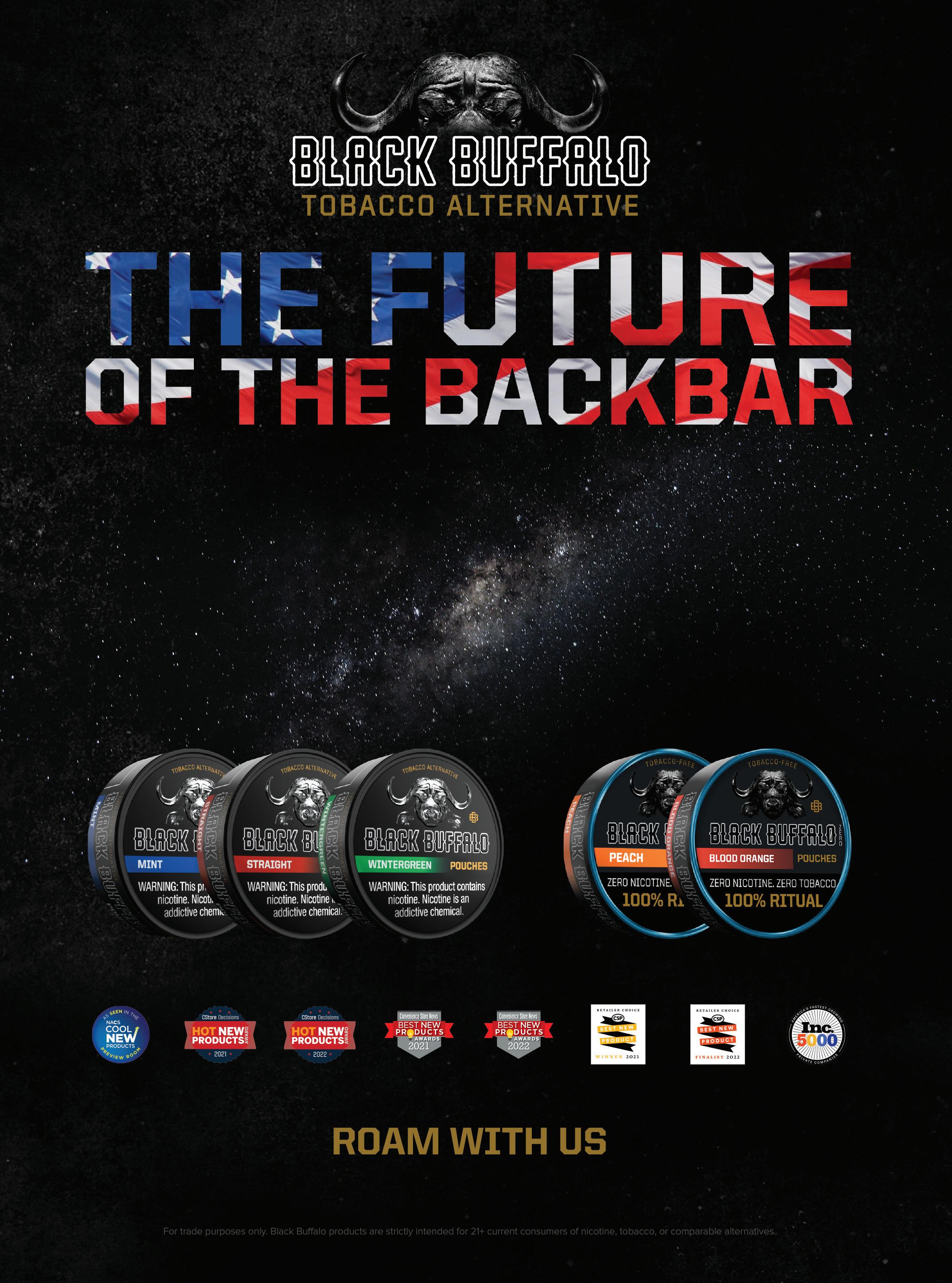
“The (discount category) share has actually increased quite a bit over the last several years, and it’s, in my view, a function of that widening gap. Also, the deep discount category has continued to take share,” said Herzog.
“There has always been a deep discount tier, but the trends have been exacerbated in recent years due to macroeconomic factors (i.e., high gas prices) and the widening price gap between premium and discount. Those two factors will determine whether the trend continues,” said Spross.
Understanding the overall tobacco market is crucial to bettering sales at a single store or chain.
“Retailers have to be on top of trends in emerging subcategories as well as within established categories to be able to be first to market with innovation and to be able to present the customer with timely value propositions throughout the year,” said The Rutter’s Cos.’ Long.


• The ruling on the Food and Drug Administration’s menthol and flavored cigar ban should take place by the end of the year.
• Price per unit is increasing in all tobacco categories, per Circana.
• Tobacco innovation continues to grow, especially with reduced-risk products.



Sheppard also noted the importance of adjusting frequently to cater to new trends.
“Play with your affinities and place items that are frequently purchased together close to each other,” she continued. “Always follow legislative topics so you know what is coming down the pipeline and do not oversaturate categories that could be impacted.”
Curby’s Suttles emphasized that organizations of any size should overall also listen to customers, as they will communicate what they want. CSD




Now that the 2018 Farm Bill is up for renewal after five years, the fate of CBD and other cannabinoids is once again up for consideration.
Zhane Isom • Associate EditorThe opportunity for cannabidiol (CBD) sales in c-stores hangs in the balance as retailers wait to learn the fate of this growing category.
In 2018, the Agriculture Improvement Act (Farm Bill) removed hemp and hemp-derived CBD from the Controlled Substance Act. Also, since the Farm Bill has been in effect, the Food and Drug Administration (FDA) announced that CBD can’t be marketed as a food additive or dietary supplement.
However, the Farm Bill is up for renewal after five years, and CBD and other cannabinoids are again up for consideration. To help find a legal pathway for CBD and other hemp-derived cannabinoid products, Congress recently announced a Request for Information (RFI), which allowed individuals to provide input on a way to create an approach to regulate these cannabinoids through Aug. 18.

“I am waiting to see how Congress will tackle hemp-derived products in the Farm Bill. Every five years, the Farm Bill is renewed. One portion of the bill passed in 2018 reclassified and redefined cannabis sativa as hemp, making it legal to grow and sell in the U.S.,” said Leah Heise, constellation advisor to global strategy and management consultancy for Kearney. “Essentially, Congress defined a plant. They did not define what the finished products were, which created a booming industry based on ambiguity. It’s time for that ambiguity to be clarified for the public and the industry itself.”
Some experts also believe that the RFI is a great way for Congress to find a way to regulate CBD products.

“As Congress continues to deliberate reform for the 2023 Farm Bill, it’s important to hear from cannabis operators, scientists, nonprofits, indus-
try groups and advocates,” said Madeline Grant, business development manager for Management Science Associates Inc. “It’s important that members of Congress consider all these thought-out priorities as it would be instrumental in providing clarity and safety to the cannabis industry.”



Even though Congress and the FDA are still looking for a way to regulate CBD products, the CBD market continues to thrive.
“The market for CBD has grown rapidly since the passage of the Farm Bill. Today, the market is projected to be valued at $7.7 billion with a valuation in 2030 of $22.05 billion,” said Heise.
Heise pointed out that CBD vape products led CBD sales at convenience stores in 2022 with $74 million in sales, according to Statista.
Consumers use different cannabinoids for












many reasons, including anxiety, pain relief, inflammation and even lowering blood pressure. Nonetheless, once there is a way to regulate cannabinoid products, the use of these products could potentially increase even more.

It’s important to remember that before the 2018 Farm Bill, there was no legal market for hempderived CBD products in the U.S. Now that the Farm Bill is in place, the CBD market is booming in most states and countries, Heise noted.
As the FDA and Congress work together to regulate CBD amidst the Farm Bill renewal, they must consider many factors to ensure the products are used safely and correctly.
“The U.S. Hemp Roundtable, with numerous other industry-leading groups, has stated research as a major priority for the 2023 Farm Bill. There is still a lot to learn about CBD and hemp products,” Grant noted. “It is extremely important that we continue to work with scientists to research and understand these products.”
Aside from doing research on the different cannabinoids as a whole, experts suggested that Congress and the FDA should also do
extensive research on the side effects and the benefits of cannabinoids.
All in all, through the renewal of the Farm Bill, experts emphasize the importance of safety and consumer access to the products.
“Any new framework should require no unsubstantiated health claims, testing for a variety of toxins, molds and additives, and should have clear labeling and packaging requirements,” said Heise. “No product should be sold without a certificate of authenticity informing the consumer of what the product contains.” CSD
• The market for CBD has grown rapidly since the passage of the Farm Bill. Today, the market is projected to be valued at $7.7 billion with a valuation in 2030 of $22.05 billion.
• Experts believe that research and hearing from other industry leaders are important when it comes to finding a new way to regulate CBD products.





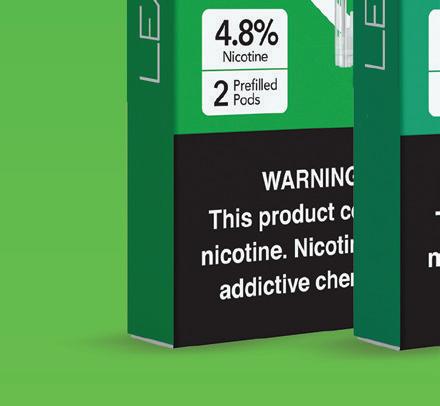
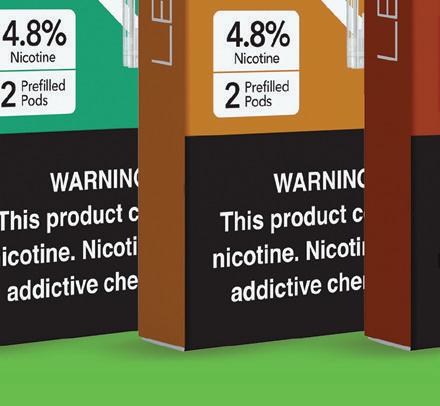
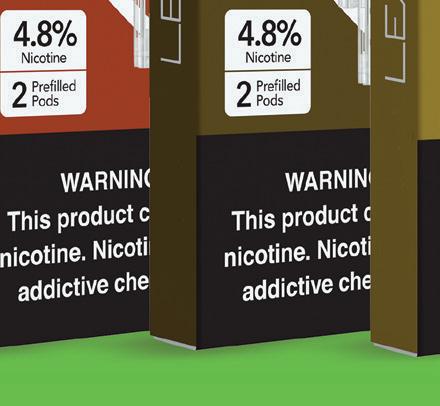




















Food packaging plays a key role in convincing customers to purchase food items. Savvy c-store retailers are paying extra attention to packaging selection as they grow their foodservice operations.
 Erin Del Conte • Editor-in-Chief
Erin Del Conte • Editor-in-Chief
As foodservice becomes a bigger focus for many c-store chains, more retailers are upgrading food packaging to better attract customers.
Packaging plays a crucial role in influencing foodservice purchases, given its ability to help maintain the quality and integrity of the food, highlight the appearance of items, and assure customers that the food is fresh and safe. Because packaging can make or break a foodservice sale, it needs to be considered early in the menu development phase.













CStore Decisions caught up with Jessica Williams, founder and CEO of Food Forward Thinking, to learn more about the latest trends influencing foodservice packaging and what c-stores should consider when selecting packaging.

CStore Decisions (CSD): What are some of the biggest foodservice packaging trends that you’re seeing in 2023?
Jessica Williams (JW): Multiuse wraps and containers with properties that highlight food quality and work for multiple food platforms. For example, a coated paper wrap that insulates burritos and sandwiches. Another example is an anti-fog, clear clamshell container that allows customers to see the food inside, but also keeps items inside crisp and hot.

CSD: We saw an emphasis on safe packaging during the height of the COVID-19 pandemic. Do you see lingering effects in how the pandemic has influenced packaging trends and consumer demands?
JW: Tamper-evident packaging is still trending. I am also seeing times and dates stamped on top of products, rather than underneath, I believe in hopes of having customers handle products less and allowing employees to check dates without handling.
CSD: If c-stores are looking to move more into order ahead and delivery, what do they need to keep in mind about packaging?
JW: Keep long-term quality in mind. Most convenience food is consumed right away, but in the case of order ahead and delivery, the food might not be eaten for 20-30 minutes. Try holding the products in the same conditions that a customer will experience them, then evaluate the food in an objective way. You may find that ventilated packaging and placing condiments and produce in separate cold containers works best for order ahead and delivery.
CSD: For convenience store retailers, when in the foodservice creation process should they start thinking about their packaging and why?
JW: Packaging should be designed exactly at the same time as the food itself, or even before. Packaging is the “vehicle” in which food is delivered into the hands and mouths of the customer. Therefore, packaging is an integral part of the experience of eating. Packaging directly impacts the temperature, moisture and texture of the food it holds, so the functionality of packaging must be considered upfront. The development time of proprietary packaging involves tools and dyes, engineers and manufacturing — so the lead times can be significant. Some retailers may be surprised to learn that even simple applications of brand colors and logos can take longer to develop than the food itself.
CSD: What are some best practices c-stores should be following when it comes to foodservice packaging?
JW: Sustainably sourced packaging is getting easier to procure every year, so when sourcing packaging, ask about options that are economically practical as well as earth-friendly. The price of environmentally friendly packaging will continue to decrease as demand increases. CSD


All Placon packages are made with post-consumer recycled PET from our very own recycling facility in Madison, WI. Most importantly, we added our patent pending tamper-evident feature on the lid, so you and your customers ensure the safety and security of the contained food.


A successful foodservice operation is as much about the people who staff it as it is about the food itself. Proper training is key to ensuring consistency in execution and food safety.
Marilyn Odesser-Torpey • Associate EditorFoodservice training is imperative for any convenience store operation, both to maintain reliable quality standards and to keep the workspace’s sanitation in peak condition. If both of these goals are met, customers will grow to trust the store’s ability to provide high-quality meals and snacks.

Kellanova® has been delivering innovative solutions and trusted brands for over 100 years. Our beloved brands offer something for every craving and include Pringles®, Cheez-It®, Pop-Tarts®, Rice Krispies Treats®, Eggo®, Club®, RXBAR®, MorningStar Farms® and more. Kellanova® is dedicated to providing ideas and solutions to help deliver delicious experiences your customers crave.
Kellanova®
263 Shuman Blvd Suite 500 Naperville, IL 60563 Ph: 877-511-5777
It’s essential to create a product assortment that offers a variety of choices, but that alone isn’t enough. Your shoppers look for new flavors to add excitement to their day1 and bring joy to mundane moments2. Offering insight-driven innovations prevents your assortment from becoming the “same old, same old” –helping you meet shoppers’ demands.
Below are trends and innovations that optimize your assortment to deliver repeat shoppers:
Taste will always be the #1 snacking purchase driver3, so look to products with “spicy” flavors that are trending with consumers4 Pringles® introduced its hottest flavor yet, Scorchin’ Buffalo, coming in at 7,000 Scoville heat units.
Growth in Millennial snacking is expected in savory flavors as well as single serve and on-the-go5. The new offerings from Club® Crisps – savory Sea Salt and Ranch crisps – are now more portable than ever in new 2oz packs.

There’s also an opportunity to capture Gen Z – the generation driving the most growth to morning snacking5. New PopTarts Bites® Cinnamon Roll, is perfect for them – combining their favorite sweet snack with the most loved breakfast pastry flavor by Pop-Tarts® fans6.
Nearly 60% of consumers enjoy trying new takes on familiar favorites7. So, look to innovations from…
• Rice Krispies Treats® – its Original Homestyle 33g Bar is now 50% larger than the original 22g bar, with gooier marshmallows, delivering 25% sales incrementality8.

• Pringles® – introduced Harvest Blends, with Farmhouse Cheddar and Homestyle Ranch flavors, and blended with multigrain.
• RXBAR® – launched RXBAR® A.M. Dark Chocolate Peanut Butter, fulfilling consumers’ demand for No B.S. with this new nutty flavor.
• Pop-Tarts® Apple Jacks® – the toaster pastry combines two beloved snacks to meet consumers’ desires for sweet snacks with nostalgic flavors9
When c-stores provide excitement and variety to shoppers – transforming their visit from a quick-bite destination into an experience that adds joy to their day –the potential for repeat visits increases10. So, keep your assortment innovative with the latest flavors they demand. The “same old” just won’t cut it.
For more information, reach out to your Kellanova® Sales Representative or call 877-511-5777.
Sources:
1. IRI, The Snacking Frenzy, April 2021, pg. 33
2. Guardians, “Shift Happens”, 2023
3. IFIC Foundation, Food and Health Survey, 2023
4. Datassential, Spice Up Summer: The Hottest Food Trends to Savor Webinar, 2023
5. NPC, The Future of Snacking, 2023
6. Circana MULO+C YTD Ending 10/30/22

7. NACS State of the Industry Report, 2021
8. NielsenIQ Connect; XAOC, L52 WE 12/31/22 –YA; Nielsen Trial & Repeat Data
9. FONA, Snacking Trend Bite, 2022
10. NCSolutions, C-Store E-Book, 2022

Foodservice training may vary from c-store chain to c-store chain, but the bottom line should always follow three basic tenets, according to John Matthews, president and CEO of Gray Cat Enterprises, a Raleigh, N.C.-based management consultant company.
“Customers want to be assured that each and every time they purchase food from your store they get: 1.) consistent product quality; 2.) high-quality customer service; and 3.) all of this done in a safe and sanitary way,” Matthews explained.
One area that is critical and often overlooked is inventory management, he added.
“Storing and rotating inventory by using the FIFO (first in, first out) method can help control food costs as well as ensure that your customers get the freshest products available,” he continued.
Matthews suggested that a combination of training devices should be used since “not all employees learn the same way.”
“It’s one thing to know the ingredient order on a sandwich, for instance, but executing that assembly at the make station can be an entirely different skillset,” he stated.

At Pak-a-Sak’s 23 (soon to be 25) convenience stores in the Texas Panhandle, each new hire is
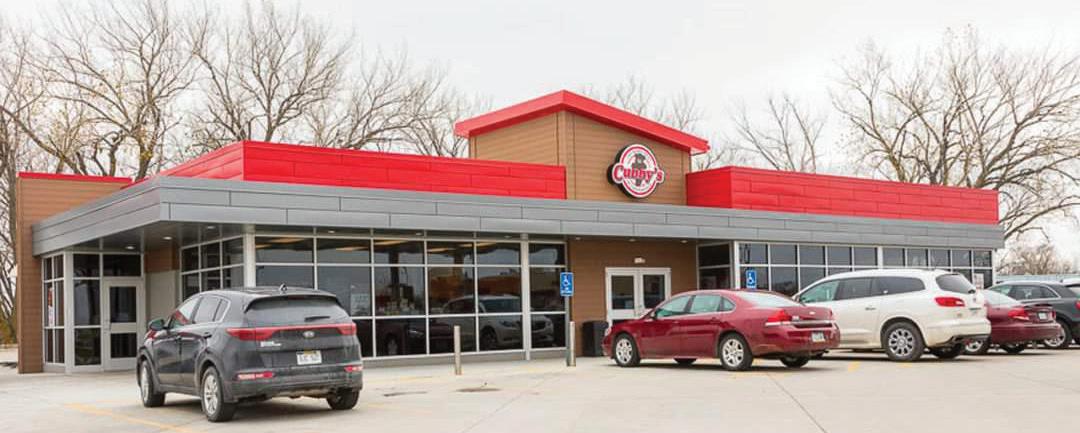
assigned to a seasoned staffer for 25 to 30 hours of training in everything from hot food holding times to handling freezer-stored food to wrapping aesthetics, said Samantha Olson, manager of Paka-Sak’s Lubbock, Texas, location.
“We emphasize that people eat with their eyes first, so even the wrappings should have crisp lines and straight folds,” she noted.
The chain’s pizza partner is Hunt Brothers Pizza, which provides print and video training materials, including a “big board” detailing how each pizza should be crafted down to how much of each topping to use for a consistent product, Olson added.
These types of training materials can be beneficial in an industry with traditionally high turnover, because new employees can quickly get up to speed on best practices.
Every crew member at Pak-a-Sak must also earn ServSafe certification. Gray Cat’s Matthews agreed that when it comes to safety education, “the more the merrier.”











At Cubby’s convenience stores, a corporate foodservice trainer works with newly hired store managers and staff for about two weeks using a combination of online, in-person, shadowing and hands-on methods, reported De Lone Wilson, president of the 41-location chain in Nebraska, Iowa and South Dakota.
In addition to its own branded foodservice products, Cubby’s partners with Godfather’s Express Pizza and Chester’s Chicken. Godfather’s has a four-day training at its Omaha, Neb., headquarters and one day in-store, and Chester’s provides video-based training and business consultants who travel to the stores upon request.
Wilson pointed out that, like at Pak-a-Sak, store and foodservice managers must be ServSafe certified.
Englefield Oil Co.’s Duchess convenience stores, with 119 locations throughout Ohio and West Virginia, employ a combination of hands-on and online training for newly hired staff members and managers, said Nathan Arnold, the chain’s director of marketing.
In addition to in-market hands-on training, a corporate training team along with tenured Duchess employees coordinate and manage all level 1 and level 2 trainings. Level 1 food safety training, which is digital and required for all in-store foodservice staffers, encompasses basic personal and product handling safety. Level 2, which all managers must complete, is more advanced in-person and handson ServSafe training that includes HACCP (Hazard Analysis Critical Control Point) knowledge.
“We follow local and state guidelines for compliance, but we go a step further in training in the Duchess way,” Arnold remarked. “Using recipe cards and detailed instructions is just a start; we find true success when we utilize Duchess team members, both the foodservice managers and others who are working in our delis every single day, to help train.”
Duchess strives to complete new team member trainings in two weeks. That includes specific food training and incorporates other cross-training learning principles, he said.
Foodservice managers also receive in-person and in-store training from Godfather’s Pizza.
Annually, all Duchess managers must also complete a foodservice refresher course. There is also a mandatory level 2 refresher course every five years.
“Our foodservice and district manager teams are in stores daily assisting them with their foodservice programs,” Arnold continued. “This includes observation and corrections as needed for foodservice best practices.” CSD
• C-store retailers should consider using a combination of training devices.
• Foodservice partners can provide training support for convenience stores.
• Scheduling periodic refresher trainings can be helpful in maintaining high foodservice standards.










More foodservice customers want healthy fare, but what customers consider “healthy” varies widely.
 Bruce Reinstein • Kinetic12 Consulting
Bruce Reinstein • Kinetic12 Consulting


Consumers today are increasingly seeking quality healthy food options from convenience stores.
Convenience stores aren’t traditionally considered go-to places for healthy food. After all, we’re the industry known for providing indulgences from sugary beverages to chips and hot dogs. While indulgent products remain central to the c-store business, as more c-stores commit to foodservice, they’re starting to adapt their menus to meet the call for healthy options.
As c-stores incorporate some healthy items on their menus, it’s important to remember that it’s not about the quantity of options available, but the quality of the offering. What’s perceived as healthy varies among customers, but overall, shoppers are seeking products that taste good, offer nutritional benefits and fit their lifestyle choices. These products must be easy to find in a grab-and-go cooler or quickly prepared behind a foodservice counter.



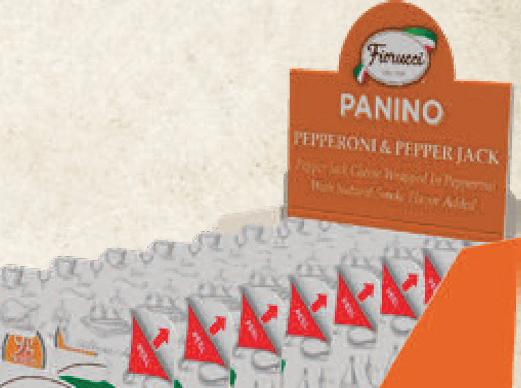



Convenient snacks are on-trend! Snacking has evolved from a once-in-a-while treat to a modern everyday lifestyle.

3 4 in


























consumers snack at least once a day, up from just 58% in 2021.
C-stores are go-to stops for products like charcuterie, a top-seller that falls under the snacking umbrella.




ranking appetizer in 2023 that is extending its reach across daypart meals — snacking included.

Discover our everyday snacking portfolio of new items with unique-to-market flavor profiles and traditional favorites.


To bring “Truly Authentic Italia” to your store’s snack lineup, visit FIORUCCIFOODS.COM






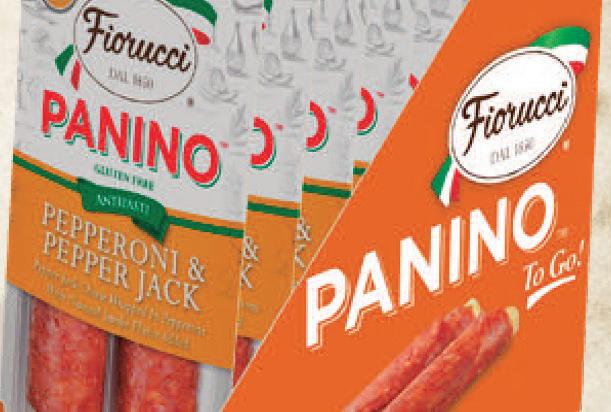





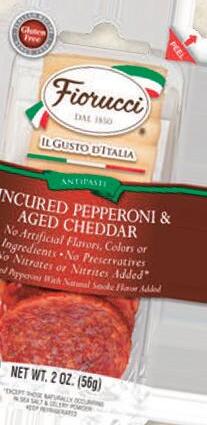




Here are six steps to meeting consumer demand for healthier options in c-store foodservice:
1. Provide the consumer with customization options. Every consumer is looking for something different, and healthier can mean something totally different to each individual. Are they comparing something to a Quarter Pounder with cheese or a turkey sandwich?
It is best to offer consumers options so they can decide how healthy they want to be, but the options must be craveable and not just there to appease the healthier customer. Any product that a consumer can build will work well. This includes bowls or wraps where you can offer a base such as rice, quinoa or lettuce; proteins such as chicken, beef or tofu; and toppings and sauces that give customers options that meet their lifestyle.
2. Meet the product standards customers are used to with a healthier twist. Healthier versions of the foods that customers are used to can be quite appealing, but it is a mistake to force healthier options into foodservice when they are not up to your standards.
Turkey burgers, for instance, have become
mainstream and providing that as an option would appeal to many customers. Sometimes you don’t have to change the ingredients at all, with the exception of the bread or wrap options. It is easy to offer sandwiches on white or wheat, but adding a healthy, sliced multigrain bread can have a major impact on the nutrition of a sandwich. Condiment options also play into healthier alternatives. Bacon is a staple, but what about avocados? They are popular and definitely healthier.
3. Provide easy options to make staple, high-volume items healthier. Breakfast remains one of the highest-volume dayparts for convenience stores, but not all customers are looking for morning pastries or bacon- and sausage-filled sandwiches. There has been a steady movement toward eggwhite options, as well as turkey bacon and sausage. Egg bites are also available in foodservice with egg white-based options being extremely popular. Providing multigrain options for breakfast sandwiches is also an easy way to provide healthy alternatives. It is a misconception that food items need to be higher in fat, sodium and sugar to taste good. Avocado toast, for example, is easy to prepare and a great healthier option for today’s consumer.










4. Offer grab-and-go items that are healthy and portable. Make it easy for the customer and give them options that are high quality, fresh and easy to eat on the go. Carrot and celery sticks, skewered fruit, tuna or chicken salad wraps, hummus, and pita bite-sized pockets are just a few examples. A grab-and-go cooler does not have to be comprised only of ready-to-eat products. Meal kits where assembly is done by the customer have potential as a c-store trend. For example, a bowl of quinoa with add-ons that customers can mix in offers customization potential. While fresh fruit, vegetables and other items associated with healthier grab-and-go are critical, incorporating this kind of engagement for the consumer can be a big hit and add profitability.

5. Highlight made-to-order items that are healthy and portable. Keep it simple. For example, consider offering one price for wraps, where customers select their wrap, spread (hummus, chicken salad, tuna salad), condiments (chopped tomatoes, cucumbers, avocado, onions) and cheese. Operators that provide the option to eat
healthier and make it easy to order, have it prepared, and eat it on the go will find their customers coming back for more.
6. Quench consumers’ thirst with some healthier beverages. Getting the largest, sweetest beverage for a great price is not what all consumers are looking for. Convenience stores have definitely raised the bar on coffee quality, including adding espresso machines to their coffee options. Surely, there are lots of bottled beverages available including water and other healthier beverages, but healthier customers are looking at the huge areas that offer fountain beverages, slushy beverages, sweet teas and indulgent beverages and wondering why there are not more options for them. There are some fabulous infused beverages now available that taste great and look amazing, and the consumer will pay more to get them. They display well in bubblers and do not require any more labor to execute.

























































Gulf Oil and Kum & Go launched revamped mobile apps and loyalty programs this year, upping their digital presence to better serve their customers with personalized attention.
Emily Boes • Senior EditorGulf Oil has relaunched Gulf Pay, through which the chain offers its customers more personalized incentives for stopping at its stores.
Gulf Oil, which has approximately 1,400 Gulf-branded stations in 36 states and Puerto Rico, recently relaunched its mobile payments and loyalty program, Gulf Pay, in March.
Gulf Pay is simple and easy to use, and its personalized customer experience helps the loyalty program stand out. For this, CStore Decisions is recognizing Gulf Oil for having one of the best new loyalty program launches this year.
“We’re looking at you, who you are, what
you care about and are really trying to provide you something that you see value in and not something that makes you feel like you’re not being listened to or that we don’t care about you,” said Nikki Fales, vice president, marketing and payments at Gulf Oil.
Gulf partnered with loyalty supplier Stuzo for the relaunch.
“Prior to (the relaunch), we had the mobile payments available. It rolled back if there was an offer, but our offers were
more static and treated like a bonus day or a long weekend offer,” said Fales.
Customers added their credit cards to the mobile wallet and paid at the pump, but Gulf lacked the ability to track customer behavior with its previous program.
“It was a little bit more of an introductory, basic type of promotional rewards program, not a consistent and personalized offer,” she continued.
The primary reason behind Gulf’s relaunch was to present its customers a more sophisticated loyalty offering.
Now, in addition to the ability to pay at the pump, Gulf customers who are enrolled in the

loyalty program have access to an offering of three cents off per gallon of fuel.
“But the best part that we have in there, and we’re just starting to roll out, is the ability to personalize a user journey and provide you possibly a different offer than the person at the pump next to you based on your buying behavior,” said Fales.
She noted that Stuzo works with Gulf on what the chain wants to provide its customers through its Wallet Steering solution, setting up different paths in a loyalty engine that trigger offers to customers based on what they’d like to see.
When customers sign up for Gulf Pay, they provide their phone number and email, as well as their method of payment.
“As you start using (the app), you’ll get asked some questions to help build out your profile and let us know a little bit more about who you are,” said Fales. “And sometimes you might get a reward for doing that or there might be an incentive to help us learn about you, but it kind of works with you as you begin using the app.”
Members will be asked questions such as “When is your birthday?” or “What products do you prefer to buy inside the store?”
One of the primary objectives of Gulf Pay is to be more thoughtful about what the chain shows to its customers. The offers being made available are ones that the individual customers are likely to be interested in.
“If we’re hoping to get people inside the store or hoping to get people to make another purchase a month or something like that we have the ability to say, ‘Once someone does X, let’s show them Y,’” said Fales.
Additionally, customers can customize their method of communication. Gulf customers can receive push notifi cations, emails, SMS messages, etc. based on their preferences.
“Giving people the ability to control how they want to be spoken to and how often is a big piece of this new app for us. It’s giving people the ability to tell us what they prefer,” said Fales.
For customers who prefer not to download an app, they can sign up for an account on a web-based browser.

Right now, Gulf Pay targets the consumer fueler. Therefore, Gulf’s Fleet Cards are not part of the new loyalty program.

“The fleet fueler has a different behavior, so that’s something that would be a separate program that we’re working on outside of this. And that’s not something we have in market today,” said Fales.
However, Gulf is working to add its gift cards into Gulf Pay by the end of the year.
“And hopefully in the future we have some type of digital gift card where maybe you can do fun things like send a gift card to your friends, if you want to, for a birthday. …” continued Fales. CSD
Gulf Oil’s new Gulf Pay app offers customers more personalized incentives for shopping at its stores.
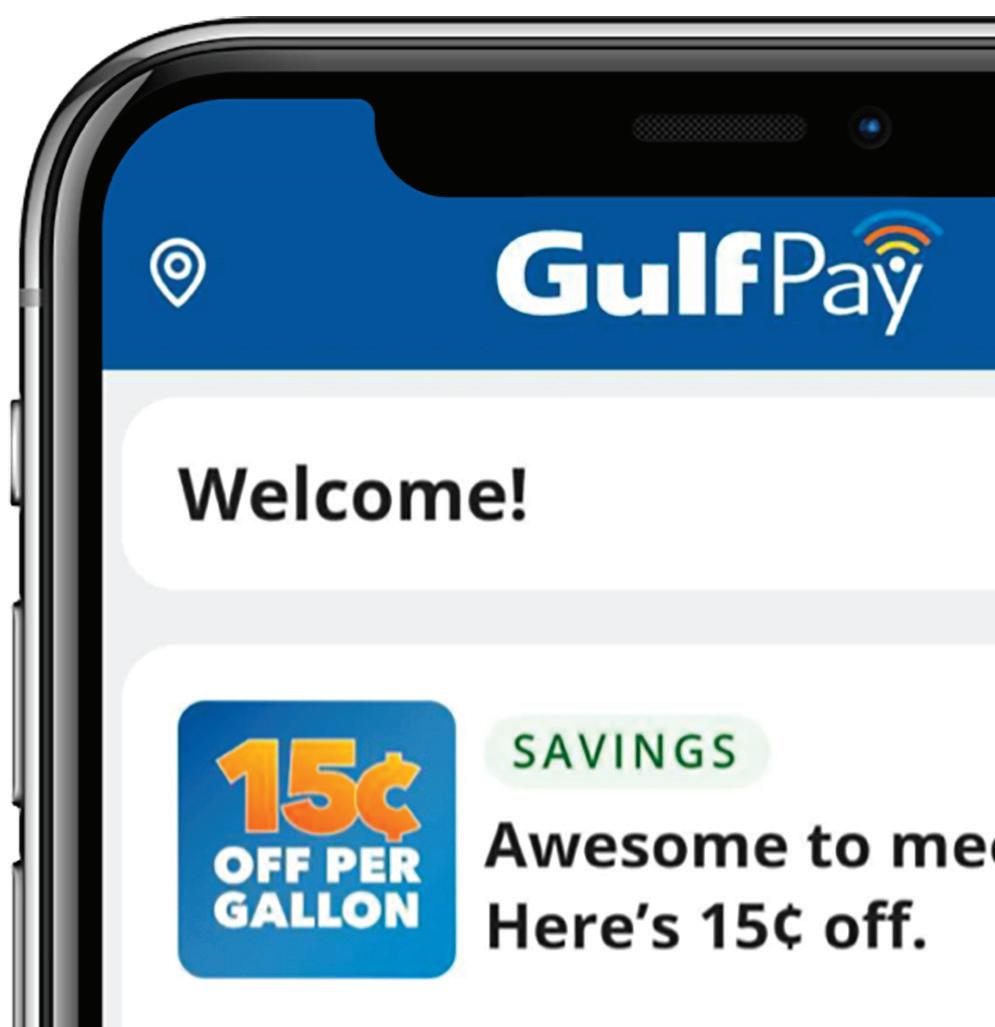
















Launched in August, Kum & Go’s new loyalty program and mobile app allow members flexibility and a higher level of communication with the chain.
Des Moines, Iowa-based Kum & Go revamped its app and loyalty program &Rewards and launched it on Aug. 1. The new app provides flexibility and a better opportunity for the chain to interact with its customers, which were its high priorities.

For this, Kum & Go has earned one of CStore Decisions’ best new loyalty program awards this year.
“We have a lot of pride in the level of personalization and flexibility that our program offers our customers,” said Matt Riezman, director of brand marketing for Kum & Go, which was acquired by FJ Management, parent company of Maverik, at the end of August. At this time, Maverik does not plan to make any changes to the &Rewards program, which will continue to serve Kum & Go locations.
Kum & Go enlisted the help of Paytronix to build the loyalty platform and Orium to set up the com-
posable mobile application. The convenience store chain created a brand-new app for the program.
“(The app) really brings our &Rewards members tons of savings and value. The big things that they find value in are exclusive offers that are just for members,” said Riezman.
Kum & Go built its new program by talking to both current members and non-members.
“One of the things we heard was flexibility was important,” said Riezman. “Some people want that &Rewards cash to use in the store; some people want fuel discounts to use at the pump. Some people don’t want to have to pick until they have to pick. We gave the option, and we’ve already seen our members getting a lot of value out of that flexibility.”
Loyalty members can earn points with every purchase, which can be spent on fuel discounts or in-store purchases.
For customers who had previously downloaded the app, a quick update to the app would bring them to the new version. This provides less friction in the migration from the old platform to the new.
Kum & Go also doubled the points of current members as they entered the new program.
For new members, once they download the app, they will provide their email address and phone number for multifactor authentication.
Kum & Go’s new and improved app and loyalty program &Rewards provide flexibility and a better opportunity for the chain to interact with its customers.
“Since we do card on file, we want to provide our customers with the best security that we can, and this is one way to do that, and it’s been shown from our reduction in theft,” said Matt Anderson, director of digital customer experience, Kum & Go.
In addition to the mobile app, Kum & Go offers its rewards members the possibility to sign up

through the website or in the store on a tablet. For customers who prefer them, the chain also offers physical cards.
“One thing that I think we feel really proud of is our welcome bundle, because when we’re asking a customer to sign up and give us information, we think that that deserves our thanks, and that’s the beginning of our relationship,” said Riezman.
The welcome bundle contains a number of free items, including products such as a slice of pizza, a small coffee and a piece of fruit. The welcome bundle also contains a fuel discount of 15 cents off per gallon on the customer’s next fill-up.
“On the new member side, we’ve seen a huge uptick in registrations in August. We’re bringing in a lot of new people, which is really exciting, and it’s really exciting for them as well to be a part of it,” said Riezman.
Kum & Go wishes to offer value to those customers who want to deepen their relationship with the chain. One of the goals of the program is lengthening that relationship.
To help accomplish this, Kum & Go is also building out non-transactional engagement points.
“We have a lot of customers that (engage outside of transactions) already on places like social media or talking to our associates in stores,” continued Riezman. “… Getting to weigh in on the next flavor of something or getting to save up your points for something beyond just &Rewards cash or a fuel discount reward (is part of the loyalty program).”

Kum & Go has a list of non-transactional options it hopes to offer to better engage with customers.
Additionally, the chain plans to leverage its data. “As we grow this program, that data becomes invaluable to us in how we interact with our customers, as well as anything that will reduce the friction from purchasing or using those points,” said Anderson.
Anderson noted that Kum & Go is continuously learning how to better the customer experience, and the chain is looking forward to having these more personalized relationships with their customers for a long time.
“This space is really ripe for innovation,” added Riezman, “and having a leader believe in us enough to say ‘let’s push the boundaries of what’s available today and set us up for tomorrow’ doesn’t happen every day. So that’s what gives me the most hope in here.” CSD







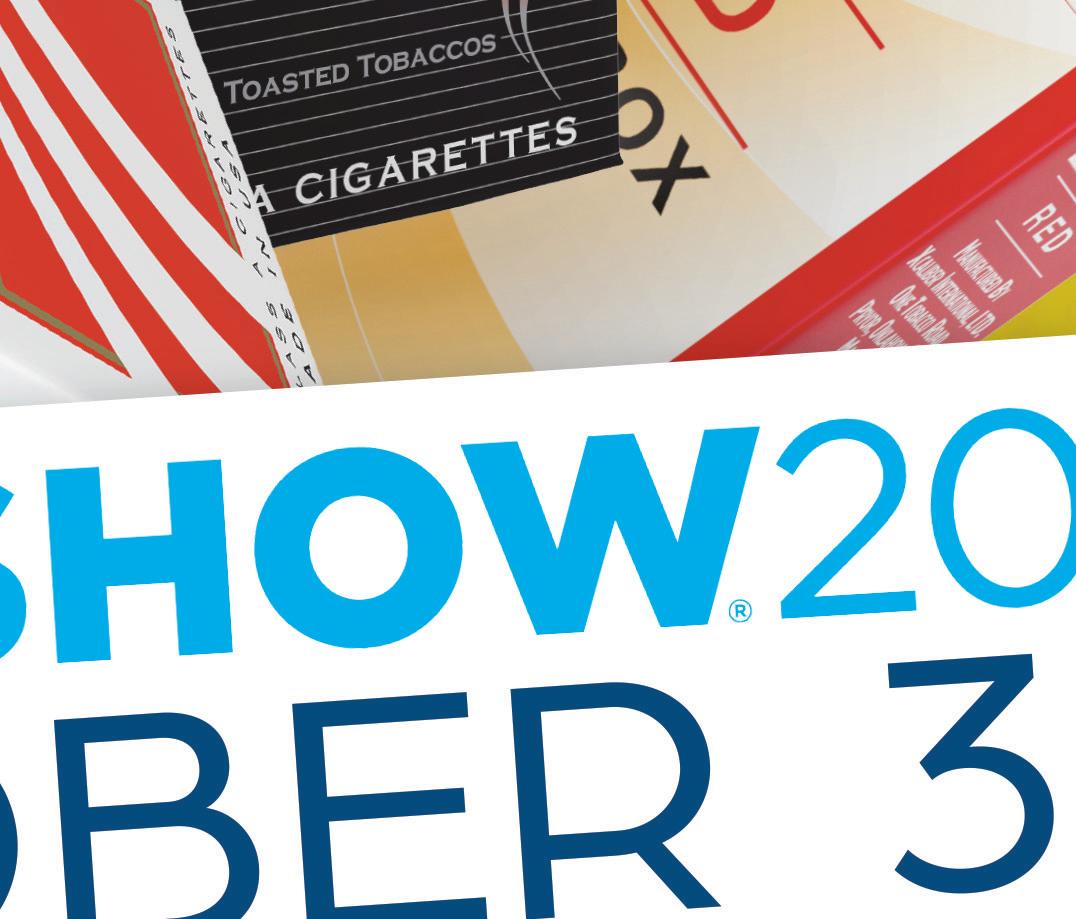






























Prepaid cards and financial services offer growth opportunities for c-stores as e-commerce and digital sales continue to advance.




As the world becomes increasingly digital, prepaid cards are providing a crucial service, not only for unbanked and underbanked customers, but also for everyday shoppers seeking a convenient gift or budgeting tool.




Case in point: Shareholders who dialed in for the August monthly earnings call for Yum Brands Inc., which owns quick-service restaurant (QSR) chains Taco Bell, KFC and Pizza Hut, were the fi rst to hear about the company’s intentions to work toward transitioning to 100% digital sales. Eventually, people could have to order solely through websites, apps or kiosks to satisfy their fast-food cravings at these brands. As a consequence, the operational change would encourage more cashless sales.







These brands join a growing chorus of businesses that view cashless transactions as potentially more efficient and secure. That said, there are those who oppose banning dollars and cents. A few months ago, Los Angeles Councilwoman Heather Hutt introduced a motion to prohibit businesses from enacting exclusively cashless systems. Several cities have taken similar stances, asserting the practice allegedly discriminates against unbanked and underbanked individuals.
Approximately 6% of adults do not own a checking or savings account, and therefore, do not use a bank-issued debit card, per the Federal Reserve Board. Plus, the Federal Deposit Insurance Corp. reported more than 14% of households were underbanked in 2021. By the agency’s definition, these individuals “had a bank or credit union account and used nonbank financial products and services.”
Nonbank financial products include prepaid cards — both closed gift cards and reloadable open loop debits — which help fill the gap for these populations. They empower everyone to participate in commerce on multiple levels. In addition to purchasing foodservice, fuel, beverages and other convenience store mainstays, these programs support e-commerce.
“In the last few years, e-commerce adoption has increased among consumers; it has also spurred increased e-gift use — even for in-store payments — since gift cards and e-gifts are compatible with digital wallets,” said Colleen Dorwart, a spokesperson for the Retail Gift Card Association. “Gift cards and e-gifts are exceptionally versatile, and since they can be used for physical or digital payments, we expect continued interest from consumers in using them for gifting, budgeting and other payments.”
However, the unbanked and underbanked only account for $100 billion of the approximately $468 billion in transactions expected to be made on prepaid cards this year, per ResearchAndMarkets.com. This payment option appeals to all types of consumers.
“Prepaid continues to drive foot traffic into our stores, and we are seeing volume increases year over year,” said Chris Hartman, vice president of fuels, advertising and development for The Rutter’s Cos., which owns and operates 78 stores in Pennsylvania, Maryland and West Virginia.
• Some 6% of Americans are unbanked, per the Federal Reserve Board.
• Approximately $468 billion will be spent with prepaid cards this year, per ResearchAndMarkets.com.
• On average, recipients spend an extra $32 when redeeming gift cards, per Capital One Shopping Research.
Indeed, it’s an investment in customer service, store loyalty and add-on business. The majority of people spend an average of nearly $32 above the value when cashing in gift cards, according to Capital One Shopping Research. When people treat themselves to gift cards, they increase the balance by 8.4% than when purchasing cards for someone else.
What’s more, financial services create unique opportunities to satisfy customers’ needs through convenience.
“As we continue to grow the business, we have added digital payment offerings and have just recently added Cash App to our program. With 40 million active users, we’re excited about the potential this presents within the category,” noted Hartman.
Cash App is a mobile payment service that allows users to make online purchases as well as buy from select brick-and-mortar stores.
Additionally, some c-stores cash customers’ checks, and there’s a burgeoning interest in “reverse ATMs” that accept cash and issue prepaid cards. Several professional ballparks, amusement parks and a spattering of restaurants have already incorporated these devices, according to news website Axios.com.
Regardless of the type and extent of financial services offered, Dorwat stressed the importance of marketing them via multiple platforms.
“C-stores can tap into new revenue streams by meeting people where they are shopping with the versatile payment tools they want,” she explained. “These programs can be advertised and promoted via a c-store’s website or mobile app. We’d recommend ensuring information about programs is front and center. It should also be easy for shoppers to find where they can buy gift cards and e-gifts when online.” CSD










Leveraging growth partners can help retailers take their digital offering to the next level.
One of the biggest opportunities for c-store growth is providing customers with a convenient and valuable digital experience through channels such as apps, websites or in-store kiosks.
Doing so not only drives customer retention and loyalty, but can also fuel significant growth for the business.
Oftentimes, however, it can seem like an impossible feat for brands to bring these digital touchpoints to the market, and for good reason: Doing “digital” can be an intimidating endeavor. Without guidance and experience, it’s hard to know where to start.

To ensure that your app, website or other digital property launches smoothly, delivers value to your customers, and helps your business thrive and grow, here are four key ingredients needed to ensure success.
It’s critical to make sure that the goals of advancing digital within your business are measurable and achievable.
The goal might be the acquisition of new customers, increasing purchase frequency for existing customers, better insights into your customer base and their behaviors, or simply to “make a splash” with innovation within the industry to increase visibility.
Defining goals upfront is critical, because numerous digital strategies can be employed to achieve each of them.
Growth can be achieved with data-driven customer relationship management (CRM) campaigns or by pairing an app or website with a compelling loyalty program aimed at acquisition, while acquisition can be driven by meaningful campaigns through digital and social channels.
Once the business aligns on its goals — and the strategies that will be employed to achieve them — it’s time to take the first steps toward using digital to reach those goals.
Cash handling can be a huge time and labor commitment – something convenience store operators don’t have enough of. SafePoint is comprised of smart safe or cash recycler technology, change order management, armored transportation, and our customer reporting platform, and is designed to make your in-store cash handling quick and easy. Leave it to the pros!

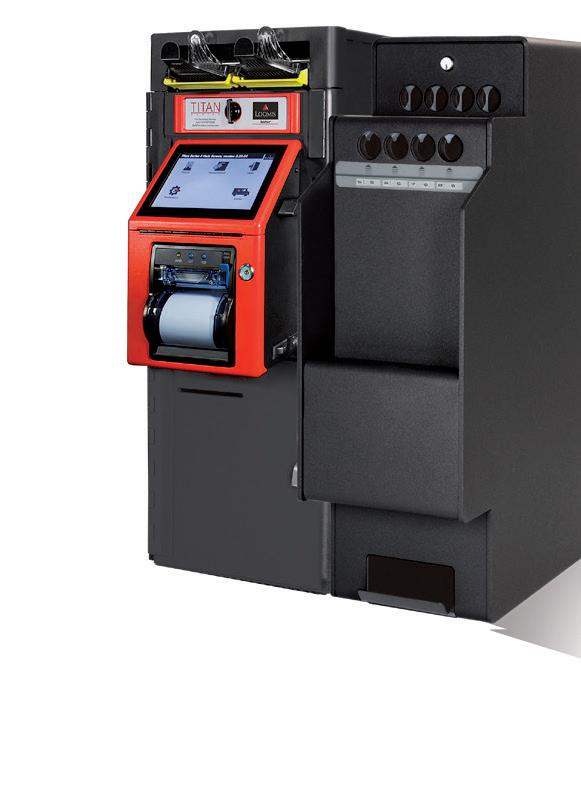
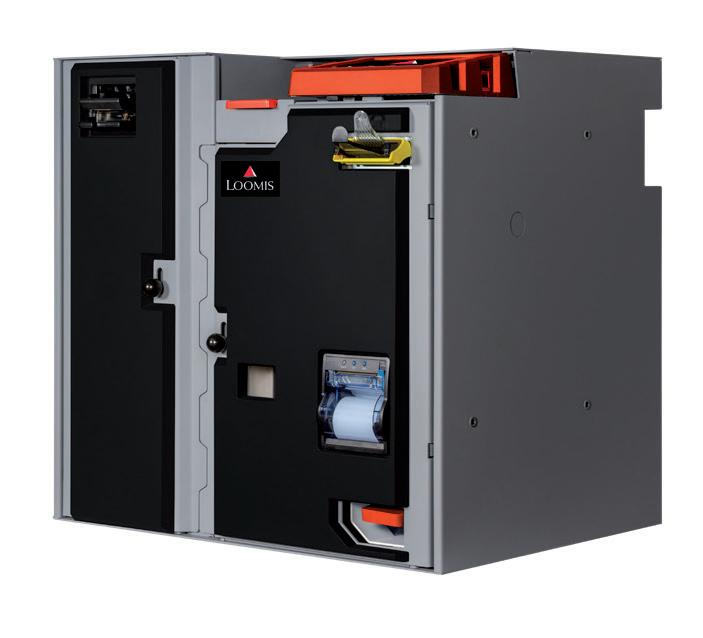

download



Behind every digital strategy is a symphony of platforms that must play in harmony to deliver value to both guests and brands.
These platforms can be off-the-shelf third-party platforms or custom-built systems that provide services, such as loyalty program management, online ordering capabilities or a customer data platform and CRM pairing.
While some larger brands go the custom route to ensure they have ultimate control over every aspect of their digital program, the more common approach is to buy customizable “white label” software-as-a-service (SaaS) platforms that provide these key services.
It can be intimidating to select the right third-party product or platform that will satisfy your business’ needs, which is why having a digital growth partner that has worked with these third-party platforms — and has built some of their own — can help optimize and maximize potential for brand growth.
Once these platforms are in place, they are incredible tools to help drive growth, incrementality, customer loyalty and ultimately make your business even more successful than it already is.
While off-the-shelf SaaS platforms typically include connectors that enable some data to flow between each other, the unfortunate reality is that these connectors often don’t enable the platforms to deliver their full potential.
At the other end of the spectrum, companies that choose to build all the components of a technology stack from scratch can ensure integrations are seamless — but the total cost of ownership increases significantly, which lowers return on investment.
While there are off-the-shelf integration-platformas-a-service platforms that can be used and that can get you the best of both worlds, they can also be cost prohibitive at large scale and/or not customizable enough to fully optimize how the platforms work with each other.
One solution is to leverage a growth partner with platform integration experience, preferably one who has a battle-tested middleware product with a deep library of existing integrations from which to pull. This can help ensure systems are fully integrated and all the information technology and marketing systems being invested in return as much of their potential value back to the business as possible.
Launching new digital properties can be an incredibly difficult endeavor. Coordinating readiness across platforms, vendor partners and internal teams takes a lot of time and focus to make sure everything launches smoothly and that your customers get the best possible first impression when engaging with what’s being brought to the market.
SaaS vendors that provide loyalty, ordering and payment platforms do an excellent job of making sure their product is properly configured and ready to launch, but without program management, integrations and cross-platform functionality can easily fall through the cracks.
After launch, brands must also invest in solid monitoring and incident response capabilities to make sure that if a component fails, it can be addressed and restored quickly. With more revenue, growth and brand engagement being driven by these digital channels, an outage for any amount of time can have a significant negative impact on your business.
When bringing digital products to the market, having a growth partner you can trust can be a secret weapon. From strategy and implementation to post-launch monitoring and support, a good growth partner can help your business bring digital products to market faster, achieve goals and key performance indicators, and catapult growth and engagement.















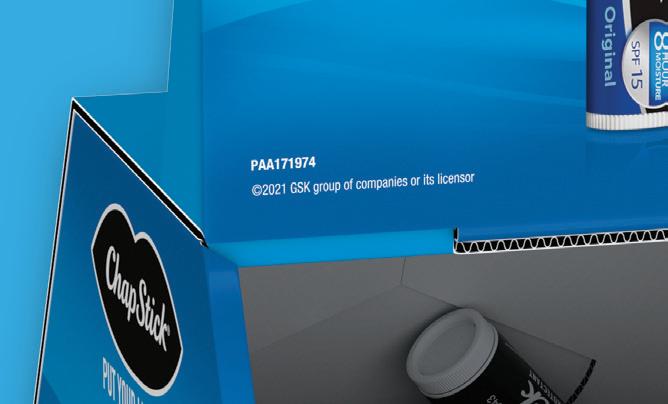













After all, handled properly, mergers and acquisitions (M&As) allow the acquiring business to gain another operation that is a good fi t under favorable terms and that might not otherwise survive.
An M&A transaction can mean helping a troubled business survive without the owners or shareholders completely losing what they’ve built up over the years. Equally important, an M&A can save the jobs of workers.





M&As refer to the consolidation of businesses through various transactions labeled as mergers, acquisitions and takeovers. In a merger, two or more convenience store businesses combine their assets and operations to form a new entity.

rates, recession concerns and new guidelines for mergers and acquisitions (M&As) are impacting activity in the market.
Mark Battersby • Contributing Editor
Given the current state of the economy, now might be an ideal time to pick up or divest a distressed convenience store business.






















































An acquisition occurs when one business purchases another, gaining control over its assets, operations and often its brand. Takeovers, much like acquisitions, occur when a business takes control of something, such as the buying out of one convenience store business by another.
Despite the many benefits of M&As, unfortunately, M&A activity has decreased recently as a result of rising interest rates, fear of recession and President Joe Biden’s sweeping new merger guidelines.
In response to Biden’s executive order outlining 72 actions by 12 federal agencies aimed at promoting competition, the executive order directed the Federal Trade Commission (FTC) and the Department of Justice (DOJ) to rewrite their guidelines on antitrust enforcement.
Although the guidelines change how large companies’ acquisitions are reviewed, they also reflect a concern with repeated small acquisitions, such as those by private equity firms that are part of an effort to “roll up” a fragmented industry.
Traditionally, M&As have generally been viewed for their tendency to create a monopoly. The new guidelines take this a step further by targeting acquisitions that do not appear to impact competition but are part of what can best be described as a conscious attempt to consolidate an industry.
The new guidelines followed the agencies’ proposed new merger qualification rules under the Hart-Scott-Rodino (HSR) Act that increased the information required in reportable mergers as well as the time and expense involved. The HSR rules also focus on private equity transactions, both in terms of identifying so-called “interlocking directorates” and prior acquisitions that could be a part of a roll-up.
The guidelines the FTC and DOJ will follow when reviewing deals focus on three core goals. The first goal is, of course, that the courts will accept them. The second is that the guidelines should be accessible, which the FTC and DOJ hope will increase transparency and awareness. And, lastly, that the guidelines reflect modern economic realities.
Specifically, the 13 guidelines the FTC and DOJ will follow when reviewing M&A deals are:
• Mergers should not significantly increase competition in highly concentrated markets.
• Mergers should not eliminate substantial competition between firms.
• Mergers should not increase the risk of coordination.
• Mergers should not eliminate a potential entrant in a concentrated market.
• Mergers should not substantially lessen competition by creating a firm that controls products or services that its rivals may use to compete.
• Vertical mergers, those mergers of two or more businesses that provide different supply chain functions, should not create market structures that foreclose competition.
• Mergers should not extend a dominant position.
• Mergers should not further a trend toward concentration.
• When a merger is part of a series of multiple acquisitions, the agencies may examine the whole series.
• When a merger involves a digital platform that acts as an intermediary connecting two or more mutually dependent groups of users such as buyers and sellers (in other words, a multisided platform), the agencies examine competition between platforms, on a platform or to displace a platform.
• When a merger involves competing buyers, the agencies examine whether it may substantially lessen competition for workers or other sellers.
• When an acquisition involves partial ownership or minority interests, the agencies examine the impact on competition.
• Mergers should not otherwise substantially lessen competition or tend to create a monopoly. M&As undeniably create vast opportunities for convenience store businesses, large and small. However, while M&As can be quite rewarding for all parties involved, they demand planning and effective execution.
An awareness of the potential pitfalls, from integration hiccups, cultural clashes, financial pressures, talent attrition and now the new guidelines for M&As issued by the FTC and DOJ, make planning essential. Thorough assessments, analysis and professional advice is more important today than ever. CSD












As the Hispanic population in the U.S. grows, c-store retailers are considering different methods for appealing to this segment of customers, such as carrying imported products or using Spanish signage.

 Emily Boes • Senior Editor
Emily Boes • Senior Editor
The population of the Hispanic community is rising, and convenience store retailers are well placed to cater to this demographic with targeted, more personalized attention.
“(C-store brands) should seek to connect with Hispanics by showing them they understand and care about their culture. Connecting with consumers at an emotional level is essentially asking for share of heart before you ask for share of wallet,” said Marina Filippelli, Orci CEO and Hispanic Marketing Council (HMC) board member.




The U.S. Hispanic population was noted as the secondlargest ethnic group in the nation in 2020, according to Pew Research Center, making up 19% of the country’s population. And, as of March 2023, Hispanic shoppers have spent 17% more than average on foodservice, per market research firm Circana.
Convenience store retailers are responding, adding items such as burritos, quesadillas, tacos and other Hispanic fare to their menus.

Yesway, for instance, added items that are inspired from Hispanic culture to its foodservice program. The chain has 440 stores in nine states.
“Given that a significant part of our store portfolio is located in eastern New Mexico and western Texas, we have quite a lot of Hispanic customers in our stores,”
said Darrin Samaha, vice president of marketing at Yesway. “Most notably, in New Mexico — within the Santa Fe and Albuquerque markets — we have seen significant growth with the Hispanic base.”
In addition to incorporating Hispanic foods into its menu, Yesway stocks products that would appeal to its Hispanic customers.
“From a merchandising perspective, we look for the right products to test and introduce into our assortment that appeal to the Hispanic base. Perhaps it’s a new product or a unique flavor profile. We’re always looking for trends that start on the product side,” said Samaha.
Texas-based Corner Store, which broke ground on its fourth site in June, also caters to a large Hispanic customer base and has been providing a product assortment that includes items that are expected to attract the Hispanic demographic.
“We provide a wide variety of imported chips, drinks, candy and chocolate from Mexico — they’re top-selling products in our locations,” said Judy Wall, purchasing/ product analyst and marketing for the chain. “We also carry chamoy-coated candies and snacks; our customers love them.”
Wall noted Corner Store places these imported products in “hot spots” in the stores and advertises them on its social media stories.
HMC’s Filippelli confirmed the effective use of social media in reaching Hispanic audiences. Additionally, she verified that Hispanic shoppers hope to find items from their home countries at c-stores.
“Hispanics look to c-stores for convenience and indulgence. At this point there is an expectation for stores to carry products from their home countries and to modify product offerings to their specific tastes,” said Filippelli. “We have seen this with the rise of popular products that have also crossed over to the mainstream, like spicy and salty snacks as well as in the beverage space.”
Filippelli noted that opportunities also exist for store-branded offerings like café de olla, pan dulce and other treats many Hispanic consumers of all generations love.
In addition to carrying products that would appeal to the Hispanic demographic, c-stores are employing marketing techniques to engage this segment of consumers.
“A brand that is serious about the Hispanic opportunity should have a yearlong marketing and media plan, tailored to fit the needs of their local audiences,” said Filippelli. “This approach is key to building brand
• The U.S. Hispanic population is the secondlargest ethnic group in the nation, per Pew Research Center.
• C-store retailers should carry products and offer services, such as Spanish translations, to appeal to their Hispanic customers.
• C-stores should have a yearlong marketing plan tailored to their Hispanic customers.
loyalty, which is of particular importance in the c-store business, as a loyal consumer can make a big difference in shopping trips and size of basket.”
As part of its marketing strategy, Yesway uses an authentic voice — communicating in Spanish — to better serve its Hispanic guests.


Filippelli supports this.
“Understanding your audience’s language use … is key. There is a place for both English and Spanish language in media and creative assets. … The right offer, based on the right location, the right product and the right language, can bring about great new opportunities for c-store brands,” she said.
Yesway also uses signage in Spanish in a subset of stores, as well as Spanish translations on its website. The chain also gets involved with the local community.
“We currently do a significant amount of event marketing and local sponsorships to ensure we’re connected with our Hispanic customer base,” Samaha remarked. “Whether it be a grand opening event in a predominantly Hispanic community or a direct sponsorship or donation to a local organization, we strive to connect not just with advertising but with real, meaningful activity in our communities.”
Focusing on generational and regional marketing can also prove effective, according to Filippelli, “given (the Hispanic community’s) propensity for multigenerational households” and the differences in interests and media consumption “from the East Coast to the West Coast and everything in between.”
“C-stores in New York City, Miami, Texas and California all have different product offerings that should be tailored to the interests of the communities they serve,” she continued. CSD
Attendance for convenience retailers is complimentary.


























RSVP today at https://COY2023. eventbrite.com

TXB features a state-of-the-art store design and restaurant-quality food, while celebrating the diversity of Texas and its values of authenticity, hospitality and integrity.




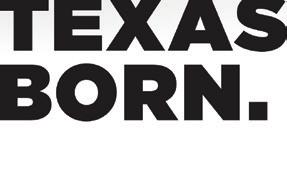


















Today TXB operates over 50 locations in Texas and Oklahoma, with plans for many more new-to-industry builds on the horizon. Over the past three years TXB has been aggressively remodeling all existing Kwik Chek sites to the TXB brand, while also growing through new builds and integrating technology, including an updated loyalty program and mobile app, self-checkout stations and electric vehicle charging.
CStore Decisions’ Convenience Store Chain of the Year Award annually honors a convenience store or petroleum chain that has established itself as a superior retailer and innovator in the c-store industry.




















CSD’s first Chain of the Year award was Wawa Inc. in 1990. TXB follows the 2022 Chain of the Year Winner Nouria Energy. Past winners of this prestigious award include Sheetz, Maverik, RaceTrac, 7-Eleven Inc., Kwik Trip, Alimentation Couche-Tard, QuikTrip, Rutter’s and Family Express.





Wednesday, October 4, 2023 5:30 - 9:00pm














































The Biltmore Ballrooms Atlanta, GA















For sponsorship information, contact: John Petersen • jpetersen@wtwhmedia.com











THANK YOU SPONSORS



 CSTORE DECISIONS HONORS TXB STORES AS THE 2023 CHAIN OF THE YEAR!
CSTORE DECISIONS HONORS TXB STORES AS THE 2023 CHAIN OF THE YEAR!
Just as c-stores incorporate new technology into their operations, car washes can also benefit from updates. Touchless systems and car wash apps are two examples.

 Howard
Howard
Riell • Contributing Editor





can bolster a convenience store’s bottom line, but with a variety of options, new technologies, sustainability concerns, differences among locations and a host of promotional possibilities, a strategy aimed at building that business can prove to be a complex one.

Mike Gewirtz, general manager of Lanman Oil Co. Inc., based in Mattoon, Ill., identified touch-free tunnel washes as the latest trend in c-store car washes. He explained that his company, which operates four Lambo’s convenience stores, three of which have car washes, has found a way to generate additional sales with its car wash setups.






































































“Install vending items for additional sales,” he recommended. “Items like air fresheners and cleaners are used every day.”
Touch-free or touchless car washes use high-pressure water and chemical solutions to clean vehicles with no physical contact — there are no moving parts that come into contact with it — thereby lessening the possibility of damage.
Touchless systems generally take less time than a commercial or do-it-yourself hand-wash. They also tend to be less expensive than other types of washes and don’t require the presence of a maintenance wash attendant to make sure the operation is functioning smoothly.
“In terms of trends, we’re still seeing rapid growth in the express exterior car wash space across the industry,” said Chris Romba, senior director of Giant Eagle’s WetGo Car Wash division. “Car washes are continuing to seek opportunities for steady and predictable revenues when it comes to tunnel car washes, which is why companies are continuing to push memberships.”
Tunnel car washes use conveyor belts to move the vehicle through a series of cleaning stations.
Giant Eagle Inc. is the parent company of GetGo Café + Market convenience stores, which operates more than 270 c-stores in five states, and WetGo car washes, which total more than 40 locations across Indiana, Ohio and Pennsylvania. Most of the chain’s washes are attached to GetGo stores, though there are three standalone WetGo locations and more scheduled in the months ahead.
Romba said he views memberships as a win-win.
“They are a great value for customers and provide a steady revenue stream,” Romba added. “With each passing year, car wash technology continues to improve. New features are rolling out that improve the customer experience, new equipment improves wash quality, and there are always new options available to improve sustainability.”
• Touch-free car washes can be faster, less expensive and have a lower possibility of damage.
• Car wash memberships have the potential to provide a steady revenue stream.
• New car wash technology and equipment are improving the customer experience.
Of course, not every convenience store retailer is convinced that car washes will prove to be a profitable venture in every market.
“It’s easy to tell you about car washes,” said Sam Odeh, president of Power Energy Corp. in Elmhurst, Ill., which has 1,359 sites in nine states, 96 of which are corporately owned under the Power Mart, Power Market and Powmaro’s banners. “We have shut all 15 of them forever. There is no way we can compete with the $3 car wash and free vacuums, to say nothing of all of the various labor issues, all the high costs of utilities and all of the maintenance. We are out and done with them, and we wish other operators all good luck.”
Technological advancements continue to render car washes more efficient and profitable for many retailers.
For example, Warrenton Oil Co. launched the Car and Truck Wash App in late May of this year.
Warrenton Oil Co. operates 59 FastLane convenience stores throughout Missouri, as well as 17 car wash locations and one FastLane Truck Wash location.
FastLane offers customers a subscription option for monthly car and truck washing, providing a frictionless and contactless solution. Customers can select from several car wash subscription packages.
Another convenience store chain, Valparaiso, Ind.-based Family Express, which operates 81 stores throughout northwest and north central Indiana, is introducing car wash kiosks at its locations in partnership with Innovative Control Systems. According to the company, the kiosks feature 15-inch touchscreens aimed at improving the customer experience.
The technology is also rolling out to sites without car washes. This will allow customers to buy car wash codes in-store and at the pump to use at Family Express car wash locations, so guests can purchase car washes when and where they prefer.
Family Express also announced that it is adding a new car wash mobile app platform in partnership with Mosaic, so customers can buy unlimited car wash subscriptions and individual washes via the company’s app. Customers will also be able to manage purchases and payment methods via their mobile wallet and gain rewards for washing their car or vehicle. Advanced geofencing capabilities will allow the company to send targeted car wash offers to customers as well.
Family Express plans to have car washes operating in 45% of locations and to continue adding new car wash operations. CSD
NAG Convenience has partnered with GALLUP® to offer tailored leadership skill training for members of the Young Executives Organization (YEO), through our newly launched Leadership Discovery Program (LDP). As part of the LDP, each participant will complete the robust diagnostic, CliftonStrengths®, to map their unique leadership strengths. Along with their peers, participants will then learn exactly how to best leverage each strength for professional growth.
The YEO LDP will run all year long with a combination of in-person and live virtual workshops to ensure the participants gain insights and actionable skills to enhance their leadership fortitude.
A career in the convenience retail industry can be demanding and yet endlessly rewarding. As younger leaders from your company take on greater challenges professionally, investing in their personal growth and development will equip them with a comprehensive foundation to excel beyond expectations.
The methodology of the CliftonStrengths® program identifies the unique combination of strengths innately within each participant. Through the bespoke resources, participants will learn ways to use their existing strengths as a catalyst to develop their individual leadership style.

Throughout the year, participants will work alongside their industry peers to harness their own strengths while learning to recognize strengths in others that can be leveraged to build teams that consistently perform to the best of their ability.
Join NAG today to ensure your rising leaders can enroll in the 2024 Leadership Discovery Program.
Free for members and non-members interested in learning about this program.


New Djarum Bliss Special and new Djarum Bliss Java have joined the four current nicotine-free Djarum Black Bliss SKUs on retailer shelves. Djarum’s six distinct Bliss flavors offer a full range of zero-tobacco clove choices for changing shelf sets. Nicotine-free Djarum Bliss Special builds on years of consumer loyalty to the smoothness of Special clove-filtered cigars. New Djarum Bliss Java offers an amazing blend of coffee aroma and clove flavor. Both styles feature the same distinctive brown wrapper and filter tip.

Kretek International Inc.







www.kretek.com

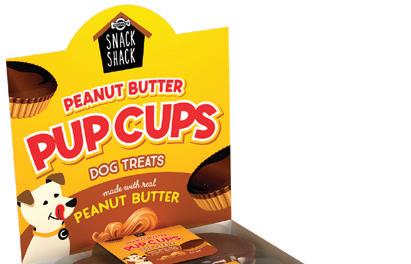
Treat Planet has released its newest line innovation of Peanut Butter Pup Cups. Furthering Treat Planet’s mission of creating the highest quality dog treats and pet products in the market, the Peanut Butter Pup Cups offer a fun, novelty option for dog owners with a convenient, on-the-go-style snack. The Pup Cups are a true celebration treat made with real peanut butter and no chocolate.
Treat Planet www.treatplanet.com

Fanta is getting ready for Halloween with its new What The Fanta Halloween beverage. The latest from the What The Fanta program captures Fanta fans’ desire for new flavor experiences. The limited-edition flavor will be black in color with a secret flavor profile that does not match its appearance. What The Fanta Halloween will be available in 20-ounce bottles and a frozen dispensed format.
The Coca-Cola Co.
www.coca-colacompany.com
CandyRific has announced its Halloween 2023 offerings, including new Disney Mickey Mouse and Minnie Mouse Pumpkin-Themed Candy Cases. Each character case includes 0.35 ounces of assorted fruit-flavored dextrose candies (natural flavors and colors). Each case also features a loop on the top to hang the character case from a chain or string and a hinged door on the back to hold candy treats. The cases are available now in two eight-count displays per case for a suggested retail price of $3.99.

CandyRific
www.candyrific.com
Excel Dryer has upgraded to electrostatic high-efficiency particulate absorbing (HEPA) filtration, which is an optional feature for its XLERATOR hand dryer models and is now available in its newly expanded, surface-mounted, ADA (Americans with Disabilities Act)-compliant ThinAir Hand Dryer product line. The upgraded HEPA filtration system uses electrostatically charged media, which allows for increased airflow and attracts particles, including bacteria and viruses, to the filter media, removing them from the air.

Excel Dryer Inc.
www.exceldryer.com
Haribo has launched its new Wild Berry Goldbears. The limited-edition gummies are inspired by consumers’ love of fruity flavors. The new gummies are also the same Goldbears shapes that fans know and love but with bursts of berry flavors: Blueberry, Wild Cherry, Strawberry, Raspberry and Wild Berry. Wild Berry Goldbears are available now in stores nationwide.

Haribo
www.haribo.com
Pillsbury has brought back its Pumpkin and Ghost Pillsbury Fall Seasonal Doughs just in time for Halloween. No measuring or mixing is required with this easy Pillsbury cookie dough. Heat, place and bake for delicious cookies in minutes. The cookie dough is safe to eat raw, so consumers can enjoy it before and after baking. The seasonal doughs are available now at various retailers for a suggested retail price of $7.

General Mills

www.generalmills.com

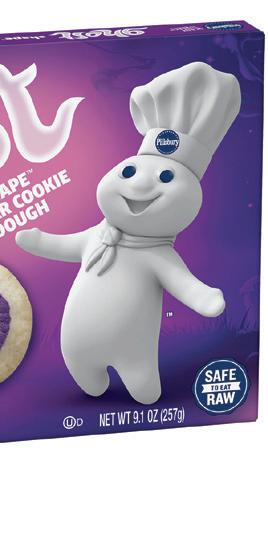

Nyco Products Co. has introduced its new NPX Bug Contact Eliminator. This bug spray is safe for people and animals when used as directed, attacking the exoskeleton of bugs and killing them within 30 seconds of contact. NPX is packaged in a convenient spray bottle that is safe to use on and around food contact surfaces, making it ideal for foodservice environments. It is designed for easy “grab and spray” whenever an unwanted pest makes an appearance.



Nyco Products Co.

www.nycoproducts.com

Lay’s has introduced Lay’s Kettle Cooked Ruffles All Dressed-flavored potato chips. After leaving shelves in 2021, Lay’s has revived the popular seasoning in a fusion between Lay’s Kettle Cooked and Ruffles in a chip that offers a tangy, savory and sweet flavor experience all in one bite. Along with the new flavor, Lay’s has reprised some hits from Flavor Swap’s past, including Lay’s Cheetos Cheese, Lay’s Doritos Cool Ranch and Lay’s Wavy Funyuns Onion. The four Flavor Swap flavors are available now at retailers nationwide.

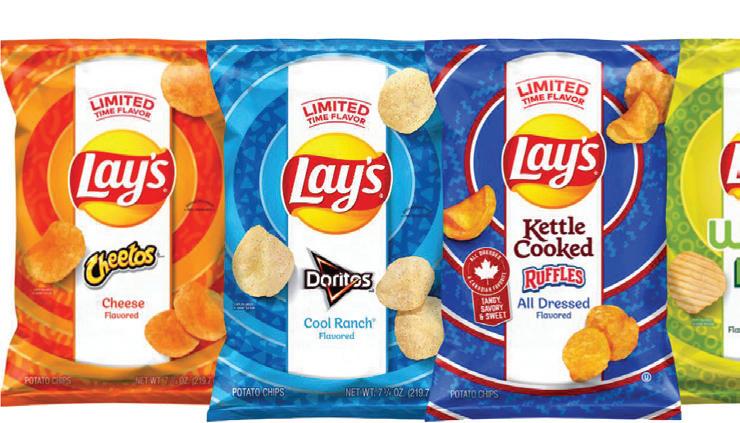
PepsiCo
www.PepsiCo.com

AyrKing has unveiled its latest product, the WC2328LT Food Prep Landing Cart. The WC2328LT Food Prep Landing Cart stands out in its ability to seamlessly integrate into dynamic foodservice environments. Engineered with a thoughtful eye on functionality, this cart helps facilitate the efficient handling of hot fried foods and streamline food preparation tasks. This cart effortlessly transforms to meet the diverse needs of modern foodservice operations. Its wide shelf lips are designed to accommodate racks, ice baths, doughnut trays and hospitality pans. The sloped top ensures spill-free food landings, contributing to operational cleanliness and efficiency.





AyrKing
www.ayrking.com




Philadelphia has brought back its Pumpkin Spice Cream Cheese for a limited time. Made with pumpkin concentrate and cinnamon, the silky, creamy spread is perfect for sweetening bagels and enhancing fall desserts. Philadelphia Pumpkin Spice Cream Cheese is available now at retailers nationwide.

Kraft Heinz Co.
www.kraftheinzcompany.com
RAGÚ has launched its new line of RAGÚ Kettle Cooked sauces. Made with premium ingredients like crushed tomato, basil, oregano and fresh garlic, new RAGÚ Kettle Cooked sauces start with slow simmering in large kettles. Featuring three flavors, including Marinara, Roasted Garlic and Tomato Basil, RAGÚ Kettle Cooked sauces can be used to create a versatile range of dishes, including pasta, soups, dips and much more.
RAGÚ Kettle Cooked sauce is available now in a 24-ounce jar at select retailers across the U.S.

Mizkan America
www.mizkan.com
Alto-Shaam has launched the reintroduction of its Quick Ship program with an expanded range of its most popular cooking, holding and serving equipment — readily available to order. Alto-Shaam’s Quick Ship program guarantees fast and convenient delivery on its most popular cooking, holding and serving models, including its latest innovation in the combination oven category, Prodigi Pro combi ovens. Models are available within Alto-Shaam’s core product categories, including Vector H Series multicook ovens, Cook & Hold ovens, Halo Heat holding equipment solutions and a range of accessories.

Alto-Shaam
www.alto-shaam.com/en
Nortera has introduced its new Arctic Gardens brand. Using a proven preservation and freezing method that allows vegetables to retain their taste, color and nutritional value, Arctic Gardens’ single vegetables and vegetable blends are a convenient and cost-effective option. Arctic Gardens offers a variety of pre-washed, pre-cut and ready-to-cook frozen vegetable products. Arctic Gardens’ latest launch features seven on-trend and flavorful products: Fusion blend, Romanesco blend, Kalebanzo blend, Riced Cauliflower, Rice Pilaf, Mirepoix and Roasting Vegetables.

Nortera Foods
www.norterafoods.com
Café Valley has introduced its new fall cupcakes, which are a part of its line of seasonal mini cupcakes. These cupcakes come in a 12-count package and can be either vanilla or chocolate and are topped with yellow and orange icing and sprinkles. The fall cupcakes are now being sold at select stores nationwide.

Café Valley Bakery
www.cafevalley.com
Sour Punch is tackling the summer heat with its new Ice Cream Truck Twists. Each 24.5-ounce bag contains different flavors, including Cherry Sherbet, Orange Cream Bar, Americana Pop and Strawberry Snow Cone, and is individually wrapped to stay fresh for summer adventures. Consumers can find Ice Cream Truck Twists at retailers nationwide for a suggested retail price ranging from $1.89 to $17.99.

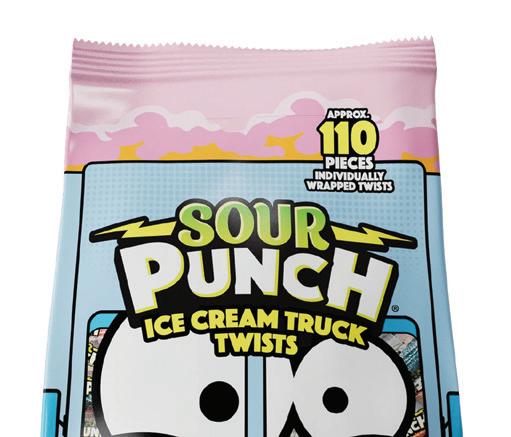
American Licorice Co.
www.americanlicorice.com









Retailers and manufacturers consider alternatives ahead of the FDA’s pending final regulations on menthol cigarettes.
John Geoghegan • Contributing Editor
The Food and Drug Administration (FDA) recently said it expects to issue an announcement “by the end of 2023” on final regulations for the proposed ban of menthol cigarettes and characterizing flavors in cigars.
If this new timetable and the FDA’s 12-month enactment period are the mileposts, c-store chains now have all of 2024 to figure out the best way forward for their tobacco sections.
Imagine we’re in the future where a nationwide menthol ban has just gone into effect, and a couple of menthol smokers visit a c-store and ask for their preferred menthol cigarette brands.
“Sorry we can’t stock or sell those anymore,” the clerk says. “But we have these new nicotinefree menthols. They say they come close. No tobacco.”
Do you think our menthol smokers will turn them down and walk out of the store? Will they opt for a pack of regular cigarettes? Do you think the taste will be close enough without the nicotine? Do you think they will come back for another pack? Will they tell their friends?
Four factors should help make their decision. First, the menthol taste must be close enough to what they expect. Next, the neural calm of menthol must be relaxing enough to buy another pack, even without nicotine. Third, the price should be $2 lower because there’s no federal excise tax. Most importantly, nicotine-free would be the only menthol smoking choice left.
While the industry waits for FDA,
it looks like tobacco-free smoking might earn a sustainable foothold beyond the internet and specialty shops. State and local tobacco units are already looking at nicotine-free, non-tobacco rules. That’s probably the strongest signal that it’s worth some shelf space.
Are retailers ready for the reality of nicotine-free menthols replacing empty slots? If 15% of current menthol cigarette smokers try a pack and half of those decide nicotinefree is better than quitting, that’s still $1.37 billion looking for a cash register even with reduced frequency. Smaller, but still sustainable.
The FDA’s science-based position is basic: Nicotine is addictive. Flavors including menthol make smoking more enjoyable. Therefore, get rid of the menthol flavor. The reality for a smoker is not so simple. Menthol creates neural and physiological pathways for relaxation and escape from stress.
The first difference smokers would notice is the absence of nicotine. Tobacco works best for nicotine delivery because it’s built into the leaf and has been engineered over the years to be enjoyable. Properly flavored, new non-tobacco blends can deliver comparable taste. Addictive or not, nothing relaxes like a smooth menthol exhale. Other than that, the taste difference between tobacco and high-quality botanical blends is becoming negligible.
Lawsuits notwithstanding, in this new c-store tobacco market the only other menthol smokers’ choices would be quitting or regular tobacco flavor. They would want the taste to be similar to a traditional menthol cigarette. After that, data would show us how many menthol smokers have enough nicotine tolerance to do without and still enjoy their smoke.
A growing focus on health is also changing the value equation. Tobacco-free will create alternative choices that didn’t exist before. How might greater availability of nicotinefree menthols affect health concerns as new choices appear on the shelf?
Not every smoker will adapt, and smoking frequency would notably decline without nicotine. I predict a new model will emerge for marketers to provide loyalty and volume incentives, and retail margins will expand with the residual benefits of new business that’s free of excise taxes in most areas.
When the FDA enacts its ban on menthol cigarettes, the tobacco landscape will change. Replacement of current shelf facings including menthol favorites will add to nicotine-free trial. How much will depend on how many smokers miss their nicotine and how retailers adapt to the new reality as it emerges.


























